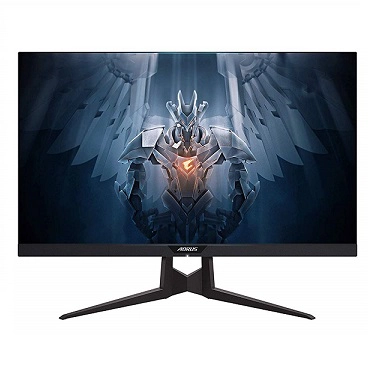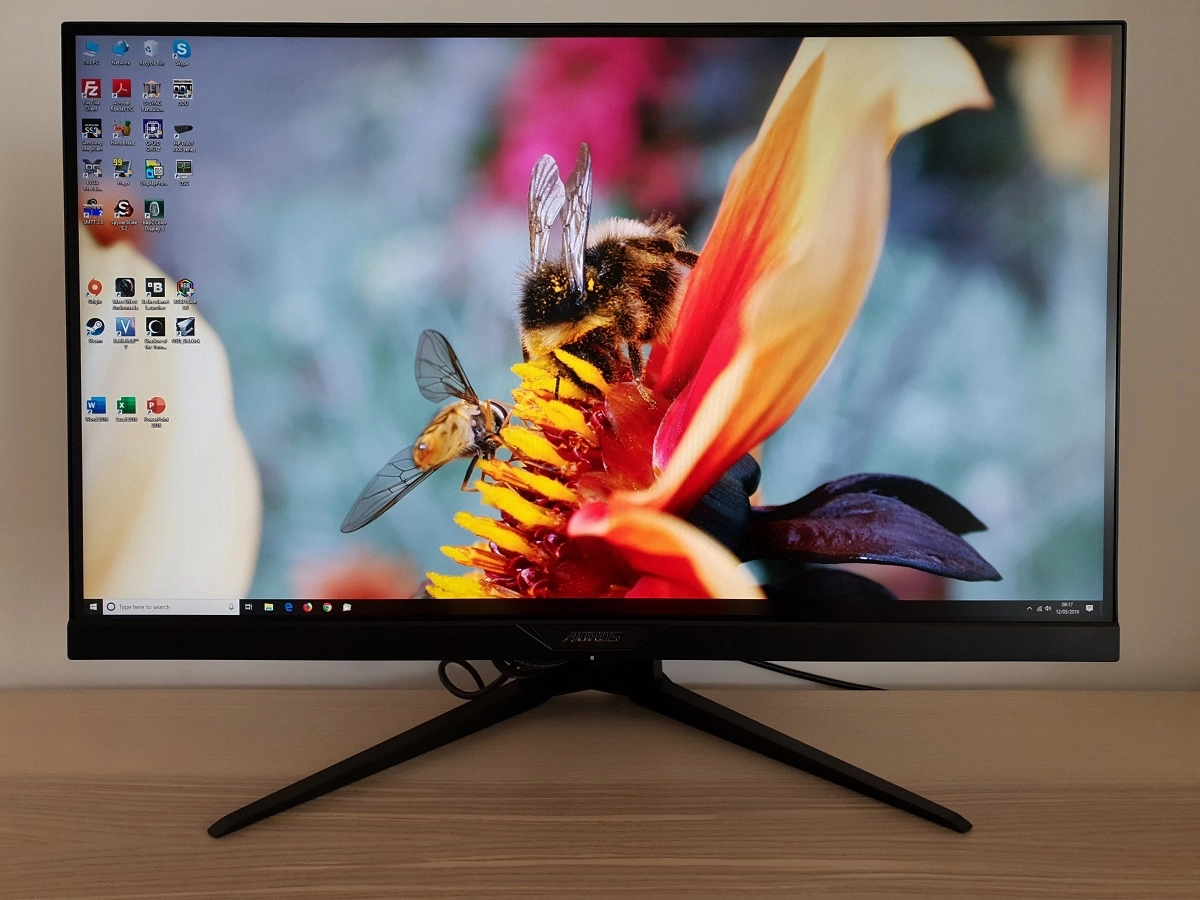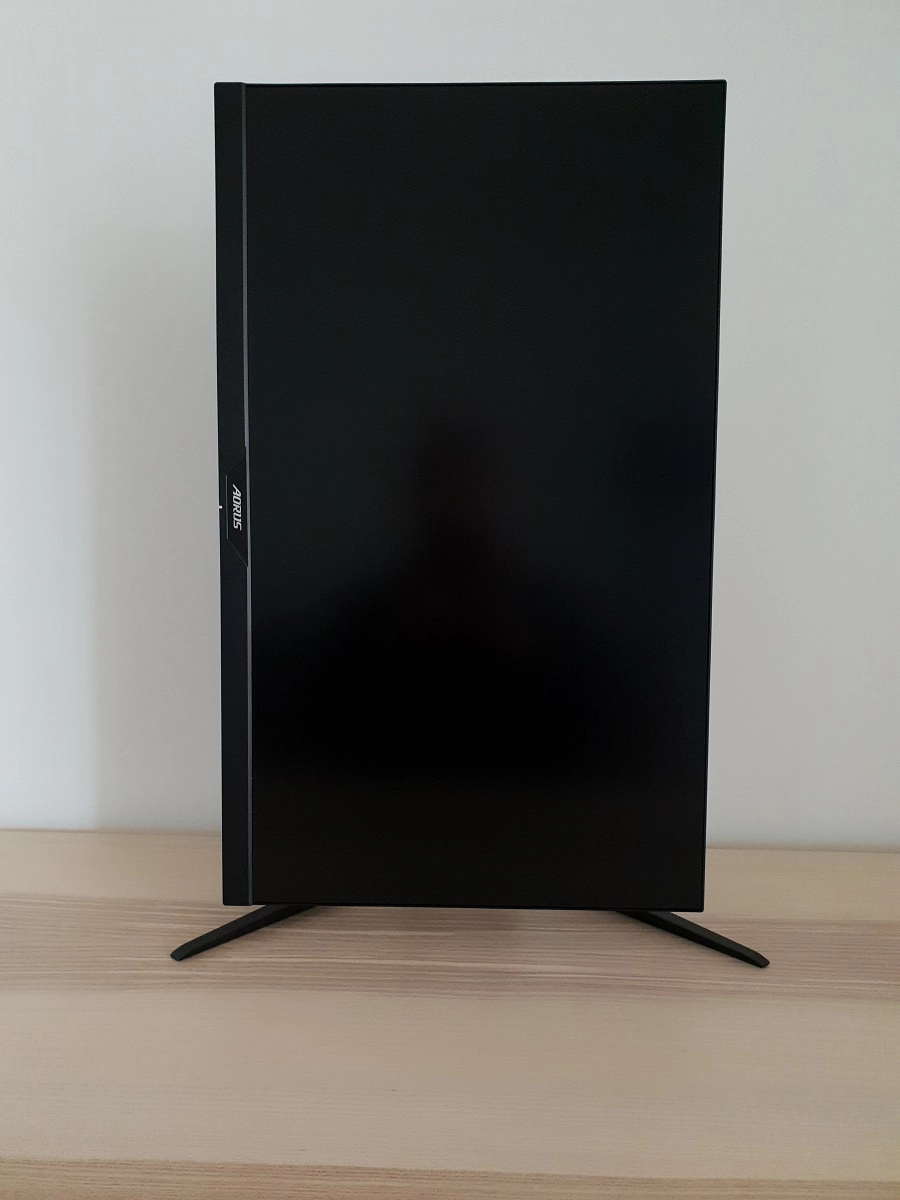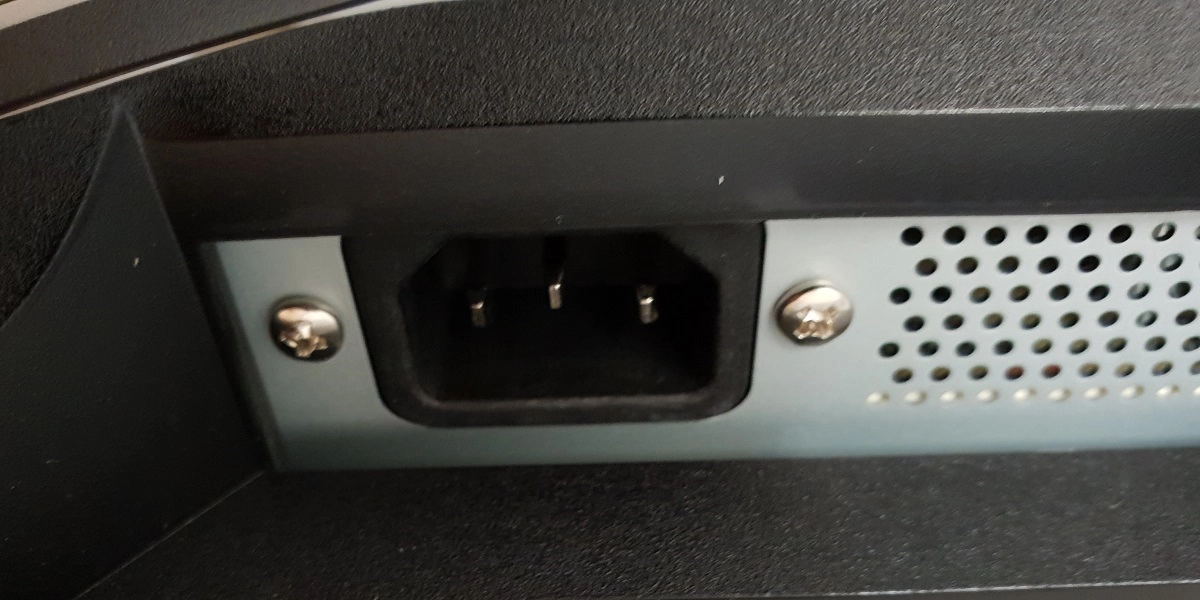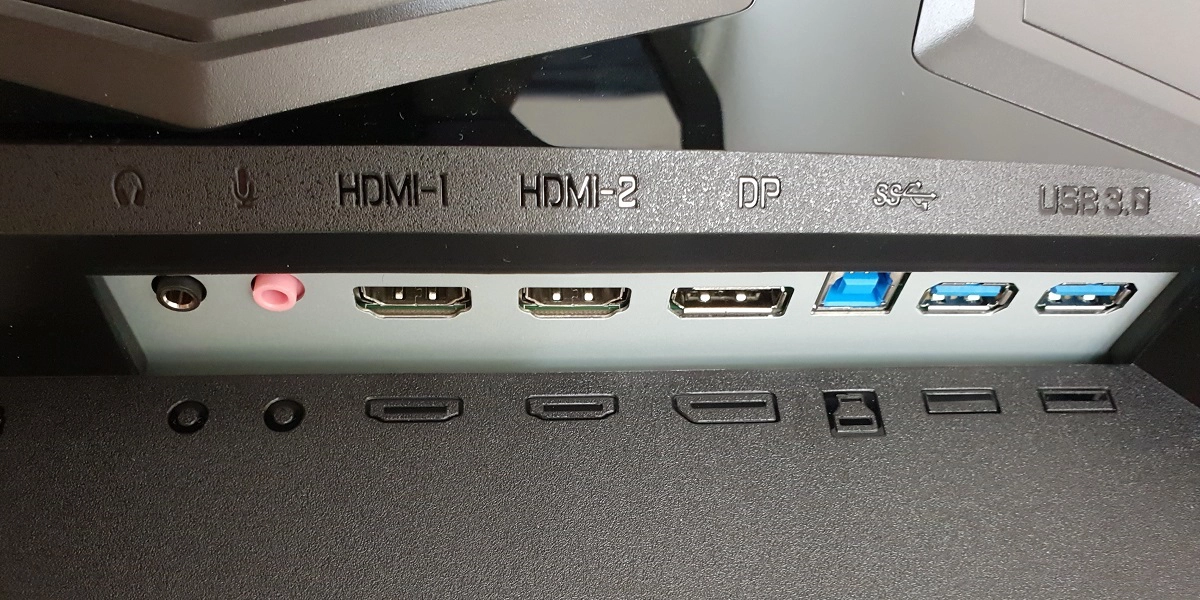Author: Adam Simmons
Date published: May 24th 2019
Table of Contents
Introduction
Gigabyte and their AORUS sub-brand are household names for many PC gamers, producing a range of peripherals and components such as graphics cards as well as gaming laptops. The Gigabyte AORUS AD27QD is their first foray into the world of gaming monitors. They’ve chosen a nice ‘sweet spot’ for many gamers, at least on paper, with a high refresh rate 2560 x 1440 IPS-type panel. We put this monitor through its paces in our usual suite of tests and see how the company’s first ever monitor performs.
Specifications
The monitor uses a 27” panel from Innolux using AAS (Azimuthal Anchoring Switch) technology. Confusingly, this technology has iterations that mimic traditional VA panels and alternative iterations which mimic IPS (In Plane Switching) technology. This is the latter, an IPS-type panel. It includes support for a 144Hz refresh rate and 10-bit colour (8-bit + FRC dithering). A 1ms MPRT (Moving Picture Response Time) is specified, with the monitor using its strobe backlight function. Some of the key ‘talking points’ for this monitor have been highlighted in blue below, for your reading convenience.
Features and aesthetics
From the front the monitor has an angular appearance reminiscent of some of Acer’s recent Predator models. The stand base has a Y-shaped design with a matte black powder-coated metal finish. Its overall design is quite gaming-monitor like, although it forgoes bright and potentially annoying colourful elements which can be particularly divisive. The monitor has a dual-stage (‘3-side borderless’) design at the top and sides, comprising a slim panel border and thin hard outer plastic component. The panel border blends in seamlessly when the monitor is switched off. Including both components, the bezel is ~7.5mm (0.30 inches). The bottom bezel is thicker with matte black plastic finish and central shiny silver AORUS logo. The logo is surrounded by a bevelled textured matte black plastic area, indented slightly the rest of the bezel. The total thickness of the bottom bezel (including a sliver of panel border) is ~2.5cm (1.00 inch). The screen surface is light matte anti-glare, as explored later.
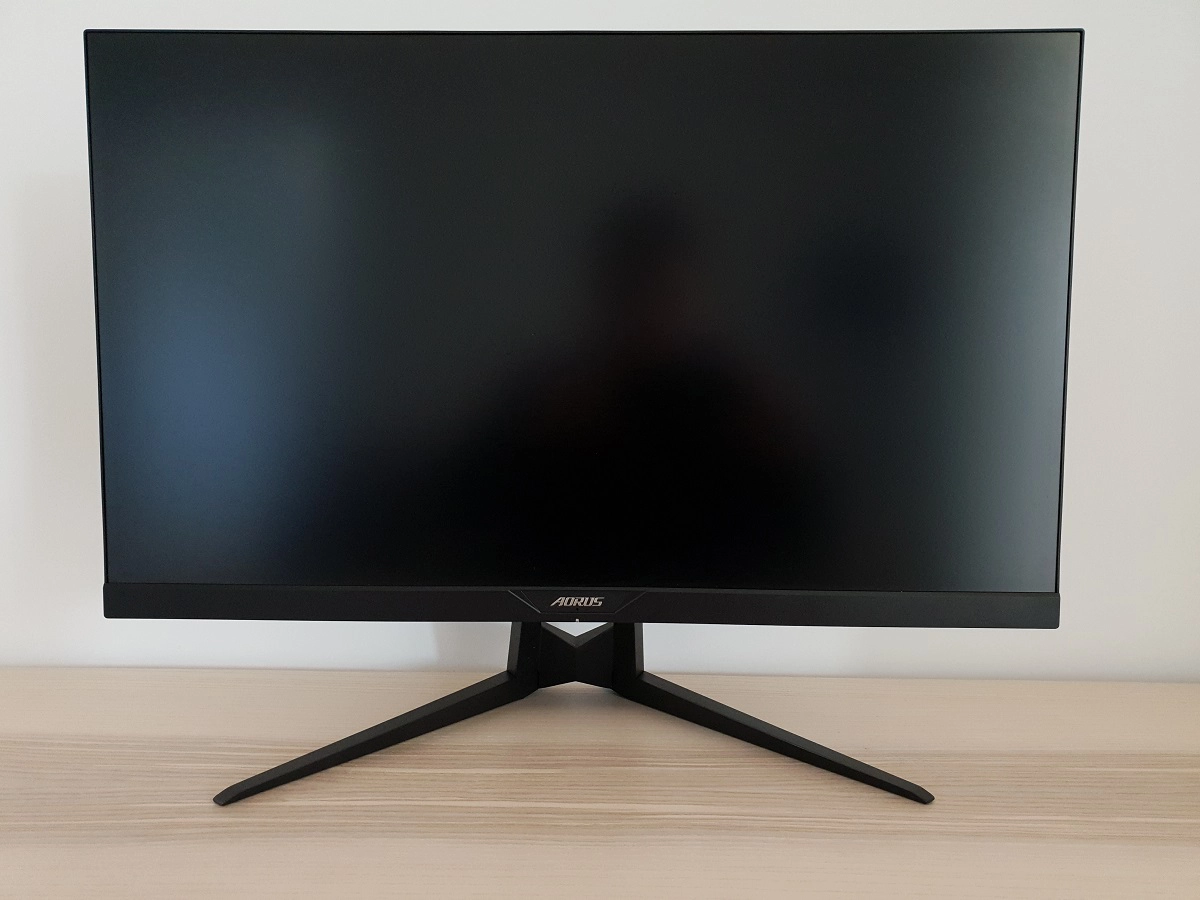
The OSD (On Screen Display) is controlled by a joystick at the bottom of the monitor, facing downwards beneath the central logo. There is a small power LED beneath the central AORUS logo, facing forwards in the central region of the bottom bezel. This glows a gentle cool white when the monitor is on and glows amber when it enters a low power state (signal to the system is lost). It can be disabled in the OSD, if preferred. This menu system and RGB LED lighting feature (controllable using ‘RGB Fusion 2.0’ software) is explored in the video below.
From the side the screen is reasonably slender, ~16mm (0.63 inches) at thinnest point but lumping out centrally towards the stand attachment point. The robust stand design is evident from this angle. The included stand offers full ergonomic flexibility; tilt (5° forwards, 21° backwards), swivel (20° left and 20° right), height (130mm or 5.12 inches) and pivot adjustment (90° clockwise rotation into portrait). At lowest height the bottom of the monitor sits ~75mm (2.95 inches) clear of the desk, with the top of the screen ~441mm (17.36 inches) above the desk. In addition to this, the carrying handle at the top of the stand neck pokes up ~51mm (2.01 inches) above the top of the screen when the screen height is set this low. The total depth of the monitor including stand is ~250mm (9.84 inches), with the screen fairly in-line with the front edge of the stand base. So not the most compact design in terms of desk depth needed, although not quite the biggest space hog out there either.
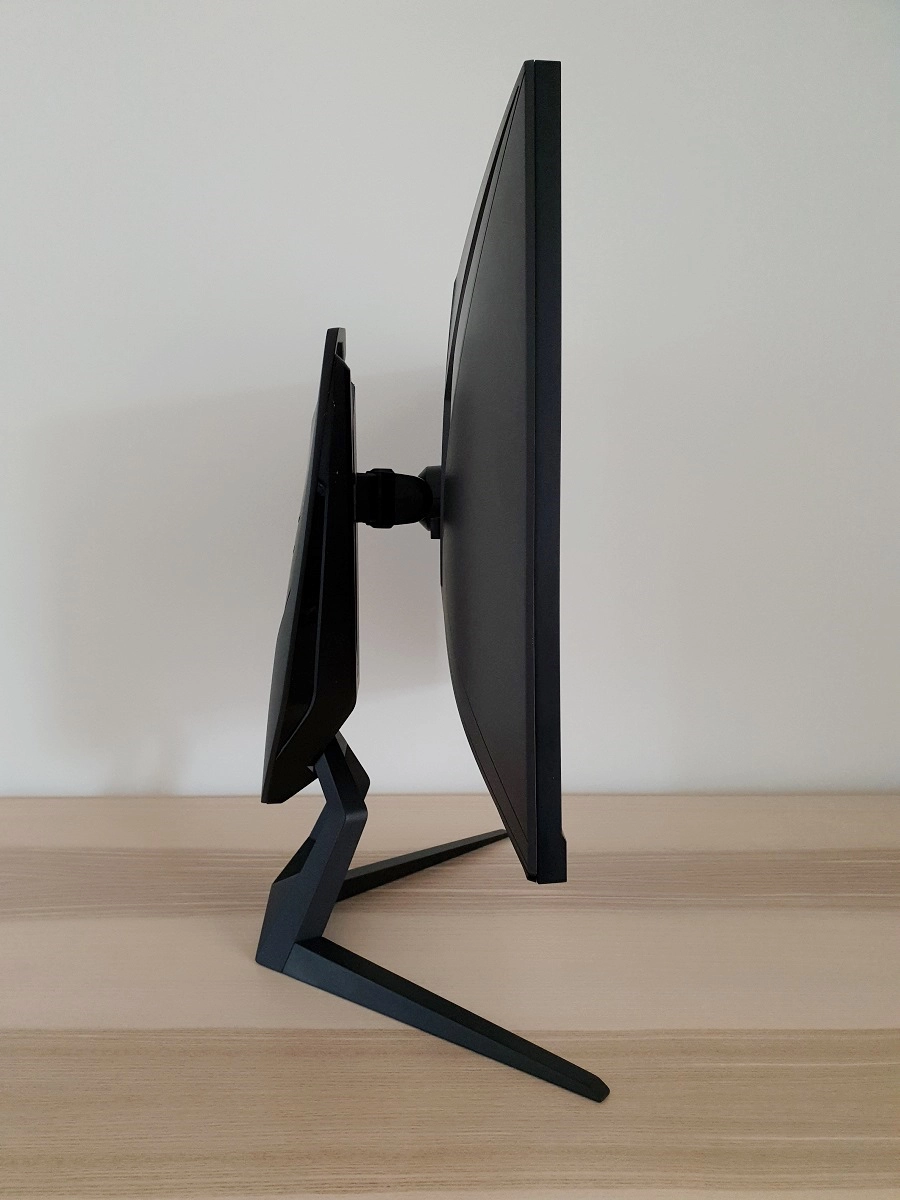
The rear of the monitor is a mixture of matte black and dark grey plastics and some glossy plastic regions. The glossy regions include some ‘channels’ either side and a central area towards the top of the stand neck. These areas house the RGB LED lighting feature, including a central illuminated AORUS falcon logo. There are additional RGB LEDs integrated into some glossy regions at the side of the stand neck. This feature is explored towards the start of the OSD video, earlier in this section. At the top of the stand neck there’s a carrying handle and at the bottom a cable-tidy loop. The stand attaches centrally and can be released and removed using a quick-release mechanism, by pinching two ‘buttons’ either side of the attachment point inwards. It can be replaced by an alternative 100 x 100mm VESA compatible stand or mount. The ports are down-firing and include; AC power input (internal power converter), 3.5mm headphone jack, 3.5mm microphone jack, 2 HDMI 2.0 ports, DP 1.2 and 2 USB 3.0 downstream ports (plus upstream). There is also a K-Slot between the power input and headphone jack.
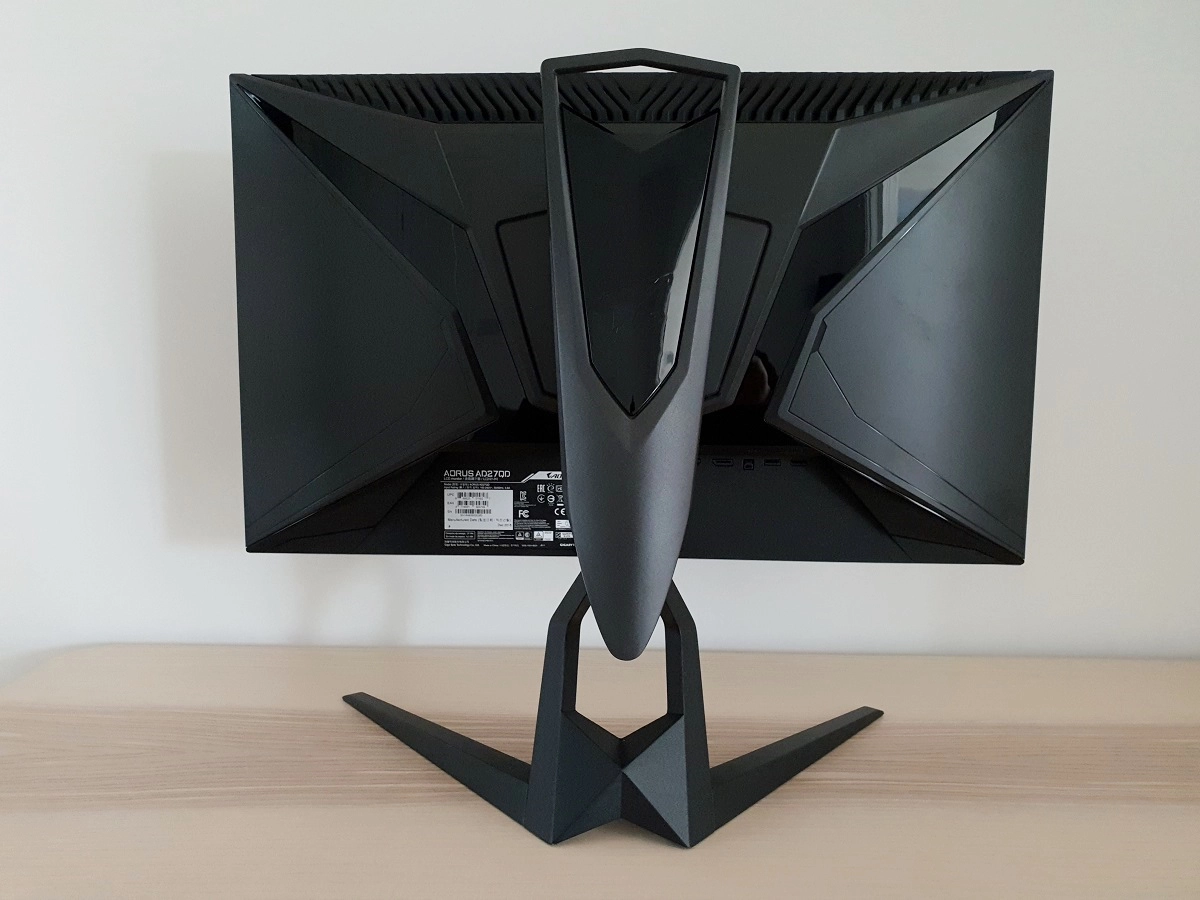
The full capability of the monitor including the 144Hz refresh rate, Adaptive-Sync (includes AMD FreeSync) and HDR can be leveraged via DP 1.2+ (for HDR the GPU must be compatible – with at least DP 1.4). HDMI 2.0 also supports these features, except for Adaptive-Sync on Nvidia GPUs (‘G-SYNC Compatible Mode’). Standard accessories include a DP cable, HDMI cable, USB cable and power cable.
Calibration
Subpixel layout and screen surface
The images below are macro photographs taken on Notepad with ClearType disabled. The letters ‘PCM’ are typed out to help highlight any potential text rendering issues related to unusual subpixel structure, whilst the white space more clearly shows the actual subpixel layout alongside a rough indication of screen surface. This model employs a light matte anti-glare screen surface with a relatively smooth surface texture. This offers fairly good glare handling, avoiding the sharp reflections observed on a glossy screen. Meanwhile, it preserves the clarity and vibrancy of the image better than some matte screen surfaces. The relatively smooth finish keeps the image free from the obvious graininess of some matte surfaces when observing lighter content. There is a light misty graininess that most users should find just fine if even noticeable at all.
![]()
As shown above, the monitor uses the standard RGB (Red, Green and Blue) stripe subpixel layout. This is the default expected by modern operating systems such as Microsoft Windows and Apple MacOS. You needn’t worry about text fringing from non-standard subpixel layouts as a Mac user and don’t need to run ClearType as a Windows user. You may still wish to run through the ClearType wizard and adjust according to preferences, however. The subpixel layout and arrangement is normal and we had no subpixel-related concerns related to sharpness or text clarity on this model.
Testing the presets
The monitor features a variety of ‘Picture Mode’ presets; ‘Standard’, ‘AORUS’, ‘FPS’, ‘RTS/RPG’, ‘Movie’, ‘Reader’, ‘sRGB’, ‘Custom 1’, ‘Custom 2’ and ‘Custom 3’. As with most presets on monitors, these are generally of little practical value to the user. They change various settings in the OSD that the user could simply adjust manually, and in some cases lock off certain settings. We will be focusing on a few of these in this section, which we do see some utility to. And also looking at various other settings that can be manually adjusted in the OSD. The 3 numbered ‘Custom’ picture modes are particularly useful as they give you full flexibility in the OSD and allow you to easily store and recall 3 different sets of settings.
The table below gives gamma readings taken using a DataColor Spyder5ELITE and white point measurements taken using a BasICColor SQUID 3 (X-Rite i1Display Pro), alongside general observations. Our test system uses Windows 10 and has an Nvidia GTX 1080 Ti connected using the supplied DisplayPort cable. Additional testing was performed using an AMD Radeon RX 580 and also using HDMI 2.0, although observations for this table did not significantly vary between the GPUs or inputs. No additional monitor drivers or ICC profiles were specifically loaded. The screen was left to run for over 2 hours before readings were taken or observations made. Aside from our ‘Test Settings’ where various adjustments are made, assume factory defaults were used. The refresh rate was set to 144Hz in Windows, although this didn’t significantly affect the values or observations in this table. When viewing the figures in this table, note that for most PC users ‘6500K’ for white point and ‘2.2’ for gamma are good targets to aim for. Individual targets depend on individual uses, tastes and the lighting environment, however.
Be aware that we upgraded the firmware to the latest available revision (‘F06’) using the OSD Sidekick utility available on Gigabyte’s website. This was a simple process that the software guides you through – it requires that the USB upstream cable is connected to the monitor.
| Monitor Settings | Gamma (central average) | White point (kelvins) | Notes |
| Gamma = OFF | 2.1 | 6832K | A cool and slightly green tint to the image and a lack of depth in places (due to gamma), but strong saturation elsewhere with strong shade variety and consistency. |
| Gamma 1 | 1.8 | 6947K | As above but marginally cooler tint and a significant lack of depth. Quite ‘washed out’ in places. |
| Gamma 2 | 2.1 | 6898K | Similar to ‘Gamma = OFF’. |
| Gamma 3 (Factory Defaults) | 2.2 | 6845K | As above but depth is now better due to appropriate gamma tracking. Image now appears vibrant and varied. |
| Gamma 4 | 2.4 | 6737K | As above but extra depth due to increased gamma. |
| Gamma 5 | 2.6 | 6707K | As above, further increase in gamma. The image looks very bold and quite cinematic, but there’s now significant detail loss in dark areas and shades. Many shades are represented in a much deeper way than intended. |
| Low Blue Light = 10 | 2.2 | 5556K | A fairly effective Low Blue Light (LBL) setting. This significantly reduces the blue colour channel and gives a warmer appearance to the image. The green channel is relatively strong, giving a green tint to the image. Your eyes adjust to this to some extent over time, although some perceived imbalances in the image remain. |
| Color Temperature = Warm | 2.2 | 5266K | A similarly effective LBL setting with similar blue channel reduction. The image now appears even warmer (red channel relatively strong) and the green channel is also reduced. This reduction in the green channel impacts contrast, as we explore later, but maintains a better balance to the image. |
| Picture Mode = Reader | 2.2 | 5420K | Similar to ‘Low Blue Light = 10’ with reduced default brightness. |
| Picture Mode = sRGB | 2.1 | 6621K | This is an sRGB emulation setting. Saturation is noticeably reduced for typical content as the colour gamut now corresponds more closely to sRGB. The image has a slight but not extreme green tint and the gamma curve sags centrally (making mid-tones brighter than intended). As explored in the OSD video, many OSD controls are locked off, including brightness (set to a moderate value) and colour channel adjustments. |
| Test Settings (see below) | 2.2 | 6518K | The brightness is now set to more comfortable levels and the white point corrected. The image is vibrant, varied and well-balanced. |
Out of the box the monitor provided a bright and vibrant image, with a slightly cool and green tint. Balance was otherwise good, whilst gamma tracked closely to the desired ‘2.2’ curve. A range of alternative gamma settings are also available. Following the adjustments made to our ‘Test Settings’, adherence to the ‘2.2’ curve remained strong, as shown below, and the overall balance to the image was good. The vibrant look remained, a function of the generous colour gamut primarily. Given the intended uses of the monitor, inter-unit variation and pleasing performance following OSD tweaking alone we will not be providing any ICC profiles for this model or using them in the review. The monitor also provided a range of different Low Blue Light (LBL) settings. The main ‘Low Blue Light’ setting can be set to varying levels of effectiveness between ‘1’ (weakest effect) and ‘10’ (strongest effect). The strongest setting provided a significant reduction in blue light output from the monitor and could be combined with reduced brightness for an even more significant effect. This setting is suitable for relaxing evening viewing or other times when reduced blue light output is desired. Particularly important in the hours leading up to sleep, where blue light exposure should be minimised to aid good quality sleep. This setting maintained a relatively strong green channel, producing a green tint to the image that the eyes only partly compensated for over time. This is designed to retain strong contrast as reducing the green channel also has affects that. An alternative ‘Reader’ mode was provided, which adds reduced default brightness into the mix (although brightness can be manually adjusted either way). Setting the ‘Color Temperature’ to ‘Warm’ provided a similarly effective reduction in blue light output whilst also reducing the green colour channel. The image appeared better balanced – we used this setting for our own viewing comfort in the evening but not for any specific testing beyond that of the setting itself. It is also possible to apply the ‘Low Blue Light’ level of your choice on top of the ‘Warm’ colour temperature setting, enhancing the effect. Although we found using the ‘Warm’ setting alone did the trick and didn’t like introducing the green tint associated with the other setting. For our ‘Test Settings’ we switched preset, reduced brightness and made some changes to the colour channels. Note that individual units and preferences vary, so these settings are simply a suggestion and shouldn’t be expected to work optimally in all cases. Assume any setting not mentioned, including ‘Contrast’, was left at default. We’ve also included the refresh rate used in Windows and our preferred ‘Overdrive’ setting, just for reference. Note that the brightness used here only applies to our SDR (Standard Dynamic Range) testing, which is the bulk of our review. HDR (High Dynamic Range) calls for a higher brightness, although it can still be adjusted according to preferences on this model– we explore HDR separately in the designated section. Brightness= 23 (according to preferences and lighting) Gamma = Gamma 3 Color Temperature = User Define Red= 100 Green= 97 Blue= 98 Overdrive= Speed FreeSync= On Refresh rate= 144Hz (Windows setting) A BasICColor SQUID 3 (X-Rite i1Display Pro) was used to measure the luminance of white and black using a range of monitor settings. This includes the settings explored earlier, in the calibration section. Static contrast ratios were recorded from these values, with results shown in the table below. Blue highlights indicate the results under our ‘Test Settings’ and with HDR active. Black highlights indicate the highest white luminance, lowest black luminance and highest contrast ratio recorded (HDR and ‘Aim Stabilizer’ deactivated). Assume any setting not mentioned was left at default, aside from the exceptions noted here or in the calibration section.
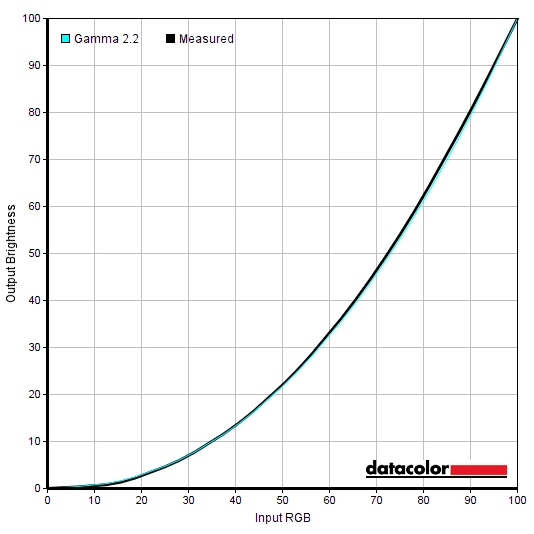
Gamma 'Test Settings'
Test Settings
Picture Mode= Custom 1 (other ‘Custom’ presets or ‘Standard’ can be used if preferred)
Contrast and brightness
Contrast ratios
Monitor Settings White luminance (cd/m²) Black luminance (cd/m²) Contrast ratio (x:1) 100% brightness 479 0.38 1261 80% brightness (Factory Defaults) 403 0.32 1259 60% brightness 322 0.25 1288 40% brightness 248 0.20 1240 20% brightness 159 0.13 1223 0% brightness 65 0.05 1300 Gamma = OFF 403 0.32 1259 Gamma = 1 403 0.32 1259 Gamma = 2 403 0.32 1259 Gamma = 4 403 0.32 1259 Gamma = 5 403 0.32 1259 HDR* (100% brightness) 481 0.37 1300 HDR* (50% brightness) 288 0.22 1309 HDR* (0% brightness) 65 0.05 1300 Low Blue Light = 10 392 0.32 1225 Color Temperature = Warm 342 0.32 1069 Picture Mode = Reader 235 0.20 1175 Picture Mode = sRGB 175 0.14 1250 Aim Stabilizer @120Hz 168 0.15 1120 Aim Stabilizer @144Hz 166 0.14 1186 Test Settings 170 0.14 1214
*HDR measurements were made using this YouTube HDR brightness test video, running full screen at ‘1440p HDR’ on Google Chrome. The maximum reading from the smallest patch size (measurement area) that comfortably covered the entire sensor area and colorimeter housing was used for the white luminance measurement, which was ‘4% of all pixels’ in this case. The black luminance was taken at the same point of the video with the colorimeter offset to the side of the white test patch, equidistant between the test patch and edge of the monitor bezel.
The average static contrast with only brightness adjusted was 1262:1, which is pleasing and about as high as you’d typically see from an IPS-type panel. Under our ‘Test Settings’ contrast dropped only slightly, to 1214:1. Contrast above 1000:1 was maintained under all settings tested in the table, which is pleasing. The lowest contrast ratio recorded was using ‘Color Temperature = Warm’ (1069:1) due to the significant changes to colour channels made there. The alternative Low Blue Light settings maintain slightly stronger contrast as they do not reduce the green colour channel. We noticed some potential contrast issues when using the ‘Aim Stabilizer’ strobe backlight function. Although the contrast dipped only slightly according to the readings presented here, it is a bit buggy in its activation. Sometimes it activated and provided a lower brightness (potentially <120 cd/m²) and a somewhat elevated black point, yielding a contrast ratio of roughly half that recorded here. There was also some fluctuation in the peak brightness of ~20 cd/m², which is more than you’d typically see when recorded luminance with a strobe backlight setting. Deactivating and reactivating the feature (or sometimes turning the monitor off then on again) seemed to stabilise the contrast and reduce the luminance fluctuations.
The highest white luminance recorded under SDR was 479 cd/m² which is quite bright, whilst the minimum white luminance recorded without loss of contrast was 65 cd/m². This is a bit brighter than sensitive users might like, but should be fine for most users. Activating HDR did not enhance contrast, providing similar results (within normal recording margin of error) to 100% brightness under SDR – with a peak luminance of 481 cd/m². The peak luminance recorded at lower brightness settings under HDR was similar to under SDR as well. The backlight lacks any local dimming functionality, simply adjusting as a single unit to the overall brightness and darkness of the screen. The monitor also provides a ‘Dynamic Contrast’ feature that allows the backlight to adjust in this way for SDR content. It can be set between ‘1’ and ‘5’ with a higher setting simply increasing gamma – even ‘1’ increases this a fair bit compared to the setting being disabled. You can manually adjust the brightness which will cap the maximum luminance, so it will only dim from there for predominantly darker content. This flexibility is nice to have, although we prefer manual control of brightness and see this (as with other typical Dynamic Contrast settings) as a compromise if not local dimming is supported.
PWM (Pulse Width Modulation)
The monitor uses DC (Direct Current) to dim the backlight and does not use PWM (Pulse Width Modulation) under any brightness setting. The backlight is therefore considered ‘flicker-free’, which will be welcomed by users who are sensitive to flickering or worried about the side-effects of PWM usage. The exception to this is with ‘Aim Stabilizer’ function active, as this is a strobe backlight function which causes the backlight to flicker at a frequency matching the refresh rate of the display.
Luminance uniformity
Whilst observing a black background in a dark room, using our ‘Test Settings’, we noticed some backlight bleed and clouding. Note that individual units vary when it comes to backlight bleed and clouding. The results on our unit are shown in the image below, taken some distance back to eliminate ‘IPS glow’. This is a predominantly golden (warm-tinted) glow that is visible most clearly towards the bottom corners of the screen, from a normal viewing position. It ‘blooms out’ from sharper viewing angles and in some regions of the screen takes on a slightly silver (cool-tinted) appearance. This behaviour is shown in the viewing angles video deeper into the review. The luminance uniformity was moderate. The maximum luminance was recorded at ‘quadrant 5’ in the centre of the screen (146.1 cd/m²). The greatest deviation from this occurred at ‘quadrant 3’ towards the top right of the screen (124.2 cd/m², which is 15% dimmer). The average deviation between each quadrant and the brightest recorded point was 9.25%, which is not terrible although not particularly impressive either. Note that individual units vary when it comes to uniformity and you can expect further deviation beyond the points measured. The contour map below shows these deviations graphically, with darker greys representing lower luminance (greater deviation from brightest point) than lighter greys. The percentage deviation between each quadrant and the brightest point recorded is also given. The Spyder5ELITE was also used to analyse variation in the colour temperature (white point) for the same 9 quadrants. The deviation between each quadrant and the quadrant closest to the 6500K (D65) daylight white point target was analysed and a DeltaE value assigned. Darker shades are also used on this map to represent greater deviation from 6500K. A DeltaE <3 represents deviation that most users wouldn’t readily notice by eye. Results here were good, with no significant deviations recorded. The greatest deviation occurred towards the top right (DeltaE 2.7). As before, it’s important to remember that individual units vary when it comes this and other aspects of uniformity. Furthermore, you can expect deviation beyond the measured points. On Battlefield V the monitor provided a reasonable contrast performance. Observing darker scenes or dark content within scenes, such as dimly lit building interiors, revealed ‘IPS glow’ towards the peripheral sections of the screen. Most notably the bottom corners, from a normal viewing position, where it ate away at detail and lightened up dark shades. This was at a level that was quite typical for an IPS-type panel of this size and by no means what we’d consider ‘extreme’. Whilst the static contrast was nothing to write home about compared to a decent VA model, detail levels for dark content in the central mass of the screen was good and appropriate. There was no obvious masking of detail nor unintended detail revealed due to perceived or measurable gamma issues. Brighter content stood out quite well against darker surroundings, with the screen surface giving the brighter content (sun in the sky, lamps in the night etc.) a fairly smooth look without obvious graininess. We also observed the contrast performance on Shadow of the Tomb Raider. The contrast was again decent overall, in-line with our expectations for the panel type and far from the weakest performance we’ve seen from an IPS-type panel. With many dark cavernous areas and poorly lit tombs and passageways, this is a title that really demands a strong contrast performance for an appropriately atmospheric look. That’s not something IPS-type models like this provide, with static contrast being decent but not outstanding and ‘IPS glow’ thrown into the mix. In a well-lit room this isn’t something you’re going to really notice, but you can’t be too precious about such things when viewing in dimmer lighting with this sort of panel type. On the plus side, the appropriate gamma handling and excellent consistency helped maintain appropriate and not overdone detail levels in the central mass of the screen. The relatively smooth surface texture of the light matte anti-glare screen surface also ensured brighter shades such as flames and daylight sky appeared without obvious graininess. We also observed the film Star Wars: The Last Jedi. As with Tomb Raider there are plenty of scenes here that demand a strong contrast performance to look their best. Epic lightsabre battles in dimly lit environments, explosions and blaster fire set against deep and dark space – that sort of thing. The film didn’t look as atmospheric as on a strong VA model, for example, but was perfectly watchable in appropriate lighting. And quite normal for the panel type in a dimmer lighting environment, too. Brighter shades were free from obvious graininess and stood out quite well against darker surroundings. There was no obvious ‘banding’ or unintended detail as gamma and shade handling was appropriate. The same observations apply to other content such as Netflix videos – there were no exaggerated ‘compression artifacts’ or anything of that nature as you might see on models with gamma or shade handling issues. The Lagom tests for contrast allow specific weaknesses in contrast performance to be identified. The following observations were made. The colour gamut of the AD27QD (red triangle) is compared with the sRGB (green triangle) and Adobe RGB (purple triangle) colour spaces in the image below. The monitor comprehensively covers the sRGB colour space (100%) with significant extension beyond this. The monitor does not offer complete coverage of Adobe RGB in the green corner of the gamut, but in the blue and red corners extends beyond Adobe RGB (88% Adobe RGB). Note that Adobe RGB overlaps sRGB on the red and blue corners of this representation. This model doesn’t specifically target the Adobe RGB colour space, however. It has a specified 95% DCI-P3 colour gamut, which is in-line with the near-term target for HDR and specifically the HDR10 standard. Our colorimeter software doesn’t support comparison with DCI-P3, but the gamut here appears to be in-line with the specified value. Also be aware that the Spyder5 tends to slightly under-report the blue region of the gamut for models with a colour gamut this wide. The colour gamut of this model gives the monitor the potential to output all shades within the sRGB colour space, with considerable extra vibrancy and saturation. The monitor gave Battlefield V a lively look with a varied palette of shades, including some noticeably vibrant ones. This vibrancy was largely a factor of the generous colour gamut, which extends significantly beyond sRGB. Content like this and other game titles (under SDR) is typically designed with the sRGB colour space in mind, so extension beyond that increases saturation levels. Elements such as roaring fires showcased excellent deep oranges and intense yellows, with a nice variety of such shades. The environments appeared vibrant but still natural overall, with some very lush and deep greens alongside some more muted shades. The more muted shades were certainly ‘lifted up’ in saturation and appeared more vivid and generally brighter than they should. But the maintenance of appropriate shade variety helped attain quite a natural look. In contrast to the ‘cartoonish’ appearance you get if you increase saturation digitally (Nvidia Digital Vibrance or a similar control on the monitor itself), which compresses shade range by pulling things closer to the edge of the gamut without expanding the gamut itself. Or with traditional wide gamut displays (~Adobe RGB) where there is huge gamut extension in the green region but not elsewhere, creating a skewed appearance rather than a more even and universal saturation boost. The IPS-type panel ensured shades were delivered consistently, too, with this vibrant appearance maintained throughout the screen. These colour reproduction characteristics were also reflected on Shadow of the Tomb Raider. The game looked vivid and lively, with plenty of licks of vibrancy. Brightly painted red, blue and gold objects and intense orange and purple flowers were just some examples of shades which stood out there. The environments appeared quite natural overall, with a nice variety of lush greens, rich earthy browns and some more muted shades mixed in. The generous gamut did tend to bring out some extra red in reddish browns and made some greens appear brighter and more vivid than intended, but the overall appearance is one many users will like. Character skin tones also reflected this extra saturation – Lara had more of a ‘glow’ to her skin than she should, but more of a ‘healthy tan’ than sunburn thankfully. The IPS-type panel ensured shades were delivered with strong consistency, too. This is in stark contrast with TN alternatives, for example, where there are noticeable saturation losses further down the screen and a much deeper look further up. Simply due to perceived gamma shifts, as observed from a normal viewing position. We also observed the film Futurama: Into the Wild Green Yonder. With large patches of individual shade, this is a particularly unforgiving test for colour consistency. As expected, the monitor put in a commendable performance in this respect. The sorts of saturation shifts you’d observe vertically on TN models or towards the bottom and edges on VA models were not present here. This enhanced the individuality of shades and allowed them to maintain appropriate identity regardless of where on the screen they were displayed. The strong vibrancy was again apparent, with saturation levels lifted up. This was again quite a universal thing, though, with appropriate variety maintained. Muted pastel shades appeared much less saturated than the vivid neon shades or strong deep shades, for example. And the neon shades (pinks, bright blues and greens etc.) certainly stood out in a rather eye-catching way. Various pastel objects and skin tones were less conspicuous by comparison, even if saturation was increased above the levels intended by the producers. Lagom’s tests for viewing angle tests were used to further explore colour consistency and viewing angle performance. The following observations were made from a normal viewing position, eyes around 70cm from the screen. On some monitors, particularly but not exclusively those with high refresh rates, interlace patterns can be seen during certain transitions. We refer to these as ‘interlace pattern artifacts’ but some users refer to them as ‘inversion artifacts’ and others as ‘scan lines’. They may appear as an interference pattern, mesh or interlaced lines which break up a given shade into a darker and lighter version of what is intended. They often catch the eye due to their dynamic nature, on models where they manifest themselves in this way. Alternatively, static interlace patterns may be seen with some shades appearing as faint horizontal or vertical bands of a slightly lighter and slightly darker version of the intended shade. We did not observe either artifact type on this monitor. We used a small tool called SMTT 2.0 and a sensitive camera to compare the AD27QD’s latency with a screen of known latency. To help maximise accuracy, over 30 repeat readings were taken. Using the method, we measured 3.43ms (a little under 1 frame @144Hz) of input lag. There was no measurable difference depending on the ‘FreeSync’ setting in the OSD. This value is influenced both by the element of input lag you ‘feel’ (signal delay) and the element you ‘see’ (pixel responsiveness). It indicates a low signal delay which shouldn’t bother even sensitive users. We don’t have the means to accurately measure input lag with FreeSync active in a variable refresh rate environment or with HDR active in an HDR environment. Our article on responsiveness explores some of the key concepts surrounding monitor responsiveness. Chief amongst these is the concept of perceived blur, which is contributed to by both the pixel responsiveness of the monitor and the movement of your eyes as you track motion on the screen. This second factor is dominant on modern monitors, although slower than optimal pixel responses are still an important contributor. We also look at ‘pursuit photography’, an image capture technique which uses a moving camera to capture motion on a screen in a way that reflects both elements of perceived blur. The images below are pursuit photographs taken using the UFO Motion Test for ghosting, where the UFO moves across the screen from left to right at a frame rate matching the refresh rate of the display. The test is set to run at its default speed of 960 pixels per second, which is a practical speed for such photographs and sufficient to help highlight key weaknesses. The monitor was tested at 60Hz (directly below), 120Hz and 144Hz with all of the ‘Overdrive’ settings tested; ‘Picture Quality’, ‘Balance’ and ‘Speed’. All rows of the UFO Motion Test were used, to show a range of pixel transitions between various shades. The final columns show some reference screens for comparison, where possible. The first is the ViewSonic XG2703-GS, a G-SYNC competitor to this model. Whilst the second is the ViewSonic XG240R, a fast and well-tuned TN model (particularly at high refresh rates) that shows how things look where pixel responsiveness isn’t really a limiting factor. At 60Hz, shown above, the UFO appears relatively softly focussed without sharp detail. This reflects a significant level of perceived blur due to eye (camera) movement. This aspect is shared with the reference shots, even the top right shot (XG240R, dark background) where pixel responsiveness is excellent for this refresh rate. There is also varying degrees of trailing behind the UFOs, caused by weaknesses in pixel responsiveness. The ‘Picture Quality’ setting offers the weakest level of acceleration, giving significant powdery trailing behind the object – particularly for the dark background (top row). The ‘Balance’ setting increases the effectiveness of the pixel overdrive, getting rid of some of this ‘powdery’ trailing. A little overshoot is introduced in places, particularly for the light background, but this is minor. The ‘Speed’ setting removes any trace of conventional trailing and instead provides strong overshoot. You can see bright and eye-catching colourful blue trailing behind the object. From this analysis and broader observations, we’d consider ‘Balance’ to be the optimal setting at 60Hz. The following image shows how things look with the refresh rate doubled, to 120Hz. At 120Hz, shown above, the UFO is significantly narrower and more sharply focused. This reflects a significant decrease in perceived blur due to eye movement. Varying degrees of trailing can be seen behind the UFOs, again reflecting some weaknesses in pixel responsiveness. The ‘Picture Quality’ setting clearly uses a level of pixel overdrive that’s too weak and ineffective for this refresh rate. There is significant trailing behind the object, with a bold appearance – particularly for the dark and medium backgrounds. The ‘Balance’ setting’ decreases this somewhat, although there are still distinct weaknesses. The ‘Speed’ setting reacts very differently to at 60Hz. It does introduce overshoot in the form of bright ‘halo’ trails, particularly for the medium and light background, but this isn’t as extreme as it was at 60Hz. From broader analysis we consider ‘Speed’ to the optimal setting at this refresh rate. The image below shows what things look like with a slight bump up in refresh rate to 144Hz. At 144Hz, above, the UFO appears very slightly narrower and more sharply focused. This indicates a slight decrease in perceived blur due to eye movement – not an extraordinary change, this is only an extra 24Hz after all. The overall pixel response behaviour is similar to at 120Hz. We again consider the ‘Speed’ setting optimal. The XG2703-GS reference shot shows some overshoot, but it’s darker and more blended (with a slightly ‘dirty’ appearance rather than ‘halo’ trailing) – in practice, this doesn’t stand out as much. The XG240R, meanwhile, gives something of a pixel responsiveness master class with a very ‘clean’ 144Hz performance. Free from any real overshoot or conventional trailing. As well as increasing refresh rate to minimise perceived blur due to eye movement, the monitor offers an alternative in the form of its ‘Aim Stabilizer’ feature. This is a strobe backlight setting that causes the backlight to pulse at a frequency matching the refresh rate of the display – either 120Hz or 144Hz. Using this mode the backlight flickers – individual sensitivity to this flickering varies. Some users may notice accelerated eye fatigue when using this setting even if they aren’t actively noticing any flickering. The pursuit photographs below were taken with the monitor set to 144Hz using its ‘Aim Stabilizer’ feature. Results at 120Hz were very similar, we decided not to include them and dedicate time to analysing them for this reason. A few reference screens are also shown for comparison, using their respective strobe backlight settings at 144Hz. The AOC AG251FG using ULMB (‘Ultra Low Motion Blur’) and a Samsung C24FG70 using ‘Impulsive Scanning’. With ‘Aim Stabilizer’, you can see that the object itself appears significantly sharper with much clearer details. You can even count the notches on the UFO body now (more or less). This indicates a significant decrease in perceived blur due to eye movement, which is the main aim of a strobe backlight setting such as this. However; you can also see a lot of trailing behind the object. This is fragmented due to the strobing nature of the backlight using this setting. There is some overshoot in places (bright ‘halo’ trailing’) but also some bold repetitions of the object itself. These repetitions are due primarily to the pixel responses not keeping up with the rigorous demands of the refresh cycle. The all-encompassing term ‘strobe crosstalk’ is used to describe this fragmented trailing around the object (behind in these examples – but it can also be in front). Because not all areas of the screen refresh simultaneously, the appearance of strobe crosstalk can differ depending on how high up or low down on the screen the movement is being observed. The image below shows pursuit photographs running from the top to bottom regions of the screen, with the monitor set to 144Hz and using ‘Aim Stabilizer’. You can see considerable strobe crosstalk throughout the screen. Further up the screen it is fainter and it’s more overshoot that’s visible. A little further down (still above centre) a bold initial trail becomes apparent, getting bolder further down the screen. In the centre of the screen, which is where your eyes spend much of their time when gaming, it’s about as bold as the object itself. This has significant implications for motion clarity using this setting, as we explore shortly. Further down the screen there is essentially a replication of the object in front and behind due to heavy strobe crosstalk – quite messy. On Battlefield V, where the frame rate kept pace with the 144Hz refresh rate, the monitor provided a responsive look and feel overall. With up to 2.4 times as much information being displayed each second compared to a 60Hz monitor (at 60fps), there was excellent precision and fluidity when interacting with the game world. This is an important part of what we call a strong ‘connected feel’ – the low input lag also helped in this respect, but that alone doesn’t deliver the sort of high refresh rate high frame rate feeling on offer here. This high refresh rate and frame rate combination also delivered a significant decrease in overall perceived blur compared to lower frame rates or refresh rates. This gave a nice competitive edge in terms of making tracking and engaging enemies easier. And some users would simply find this less ‘dizzying’ than gaming on significantly slower screens. There were some weaknesses in terms of pixel responsiveness, however. Although most pixel transitions occurred fast enough for a very competent 144Hz performance, some pixel transitions were slower than optimal. Even using our preferred ‘Speed’ overdrive setting. These weaknesses were most evident for some very light and very dark shades (high contrast transitions) and formed a ‘powdery’ trailing that extended back from the object a bit. This was nowhere near as noticeable as the sort of ‘smeary’ trailing you’d typically see for such transitions on a VA model, however. And it was secondary to a more noticeable issue; overshoot. There was a moderate amount of this in places, particularly where lighter shades were involved in the transition. Playing on brighter maps revealed this usually as a sort of over-sharpening during movement due to widespread ‘halo’ trailing that is brighter than either the object or background colour. There were some less subtle and more eye-catching examples of overshoot as well. Such as the bright flashes of cyan that trailed behind dark grey or green aircraft as they moved against brighter areas of sky. Or moving past lightly painted buildings with fairly deep (saturated) blue sky in the background, producing overshoot trailing that was significantly brighter than the object or background colour. Scrolling pages with dark text on a light background on the desktop revealed this stronger overshoot as well. Overall, the overshoot was more noticeable and widespread than on the Dell S2719DGF and somewhat more noticeable than on the S2716DG we tested, using our preferred settings in all cases. But it wasn’t what we’d consider extreme overshoot and isn’t something every user would find bothersome. Some examples of this are shown in the video below. We also observed movie and video content at a variety of frame rates, including ~24 – 30fps and 60fps content. Naturally, such content didn’t put the refresh rate of the monitor to such good use – but weaknesses were not really pronounced, either. There were some instances of overshoot even for the lowest frame rate content (~24fps), but this was not widespread, it was short and sharp and not something we found eye-catching. There were no obvious weaknesses in terms of slower than optimal pixel responses. So overall, a good performance from the monitor for such content – and it’s really the frame rate of the content itself that’s the main barrier to fluidity. AMD FreeSync is a variable refresh rate technology, an AMD-specific alternative to Nvidia G-SYNC. Where possible, the monitor dynamically adjusts its refresh rate so that it matches the frame rate being outputted by the GPU. Both our responsiveness article and the G-SYNC article linked to explore the importance of these two elements being synchronised. At a basic level, a mismatch between the frame rate and refresh rate can cause stuttering (VSync on) or tearing and juddering (VSync off). FreeSync also boasts reduced latency compared to running with VSync enabled, in the variable frame rate environment in which it operates. FreeSync requires a compatible AMD GPU such as the Radeon RX 580 used in our test system. There is a list of GPUs which support the technology here, with the expectation that future AMD GPUs will also support the feature. The monitor itself must support ‘VESA Adaptive-Sync’ for at least one of its display connectors, as this is the protocol that FreeSync uses. The AD27QD supports FreeSync via DP and HDMI on compatible GPUs and systems. Note that HDR can be activated (at the same time as FreeSync) via DP 1.2+ or HDMI 2.0. If fully installed, AMD drivers feature Radeon Settings, which makes activation of the technology very simple and something that usually occurs automatically. First make sure that you have ‘FreeSync’ set to ‘ON’ in the ’Gaming section of the OSD. You should then make sure the GPU driver is setup correctly to use FreeSync, so open ‘AMD Radeon Settings’ and click on ‘Display’. You should then ensure that the first slider, ‘AMD FreeSync’, is set to ‘On’. If you hover over this, it will also report the variable refresh rate display supported by the display. VSync is configured in the ‘Gaming’ section of ‘Radeon Settings’, where it is referred to as ‘Wait for Vertical Refresh’. You can either configure this globally under ‘Global Settings’ or for each game individually. The default is ‘Off, unless application specifies’ which means that VSync will only be active if you enable it within the game itself, if there is such an option. Such an option does usually exist – it may be called ‘sync every frame’ or something along those lines rather than simply ‘VSync’. Most users will probably wish to enable VSync when using FreeSync to ensure that they don’t get any tearing. You’d therefore select either the third or fourth option in the list, shown in the image below. The final option, ‘Enhanced Sync’, is a relatively new addition to the driver. This is an alternative to VSync which allows the frame rate to rise above the refresh rate (no VSync latency penalty) whilst potentially keeping the experience free from tearing or juddering. This requires that the frame rate comfortably exceeds the refresh rate, not just peaks slightly above it. We won’t be going into this in detail as it’s a GPU feature than a monitor feature. We used this monitor with various game titles, with FreeSync enabled, and as usual found things works much the same way on all titles. If any issues were identified on one title but not another, it would indicate an issue with the game or GPU driver rather than the monitor. We’ll therefore simply focus on a single title for this section; Battlefield V. With a high level of flexibility with its graphics options, this is also a suitable title to use to test the full range of refresh rates supported. With the Radeon RX 580 used in our test system, maintaining a consistent 144fps at 2560 x 1440 was difficult on this title. Even with some significant graphical compromises, dips below this were common. Without FreeSync active, these dips resulted in obvious (to us) tearing if VSync was disabled or stuttering if VSync was enabled. Even if the dip was only very slight. Sensitivity to such issues varies, but we were certainly glad to see FreeSync take care of these issues by eliminating frame rate and refresh rate mismatches. Driving up the graphics further and bringing average frame rates closer to 100fps again highlighted the advantages of the technology. Tearing and stuttering from refresh rate and frame rate mismatches was eliminated, helping this flow better. The reduced frame rate was still noticeable to us, however. The level of perceived blur was significantly higher than at 144fps and ‘connected feel’ was noticeable worse. The overall perceived blur level and ‘connected feel’ was still quite decent at ~100fps, though, and playability was certainly better than at significantly lower frame rates. A particular issue we had, though, was that the already moderate to strong overshoot now became stronger and in some cases quite extreme. There were bright ‘halo’ trails that really caught the eye and these were quite common. Reducing the ‘Overdrive’ setting to ‘Balance’ greatly reduced the overshoot, but there were some notable instances of conventional trailing instead. Particularly where darker shades were involved in the transition, there was almost a VA panel like smeary quality. This was reduced somewhat compared to at higher frame rates, simply as the pixel response demands are lower, but it still significantly impacted perceived blur. As frame rate dropped further (due to ramping up graphical settings, for example), FreeSync still did its thing. But the overshoot levels became extreme – if you’re frequently well into the double digits, closer to 50fps than 100fps, we’d actually recommend sticking with the ‘Balance’ overdrive setting. It certainly isn’t perfect as there are still some stand-out weaknesses in pixel responses (‘powdery trailing’) that aren’t present with the ‘Speed’ setting. But the lower pixel response requirements at these reduced frame rates meant they didn’t stand out in the same way and didn’t impact the perceived blur so severely. It is common for FreeSync models to exhibit issues such as more noticeable overshoot when refresh rate decreases, although this model was even worse than average in that respect. It’s something that G-SYNC models generally handle a lot better, with Nvidia employing ‘variable overdrive’ that slackens off the aggressiveness of the pixel overdrive appropriately as refresh rate reduces. FreeSync monitors such as this tend to be tuned for their maximum refresh rate and don’t adjust the response behaviour (reduce acceleration levels) appropriately as refresh rate reduces, leaving behind more extreme overshoot. This is tied to a drop in refresh rate, specifically, so isn’t observed if you run the monitor at a static 144Hz even if the frame rate drops. Where the frame rate dipped below the floor of operation for FreeSync (48fps / 48Hz, LFC (Low Frame Rate Compensation) kicked in. This kept tearing and stuttering from frame rate and refresh rate mismatches at bay, ensuring an even division of the frame rate into the refresh rate. There was a momentary stuttering when this activated or deactivated, something we commonly observe, but this was not extreme and isn’t something most users will notice unless they’re consistently passing the LFC boundary (48fps). As noted earlier, AMD FreeSync makes use of Adaptive-Sync technology on a compatible monitor. As of driver version 417.71, users with Nvidia GPUs (GTX 10 series and newer) and Windows 10 can also make use of this Variable Refresh Rate (VRR) technology. When a monitor is used in this way, it is something which Nvidia refers to as ‘G-SYNC Compatible’. The AD27QD is amongst models which are specifically validated as G-SYNC compatible, which means it has been specifically tested by Nvidia and passes specific quality checks. With the AD27QD, you need to connect the monitor up via DisplayPort and enable ‘FreeSync’ in the ‘Gaming’ section of the OSD. When you open up Nvidia Control Panel, you should then see ‘Set up G-SYNC’ listed in the ‘Display’ section. Ensure the ‘Enable G-SYNC, G-SYNC Compatible’ checkbox and ‘Enable settings for the selected display model’ is checked as shown below. Press OK, then turn the monitor off then on again so that it re-establishes connection – the technology should now be active. Our suggestions regarding use of VSync also apply, but obviously you’re using Nvidia Control Panel rather than Radeon Settings to control this. The setting is found in ‘Manage 3D settings’ under ‘Vertical sync’, where the final option (‘Fast’) is equivalent to AMD’s ‘Enhanced Sync’ setting. You’ll also notice ‘G-SYNC Compatible’ listed under ‘Monitor Technology’ in this section, as shown below. Make sure this is selected (it should be if you’ve set everything up correctly in ‘Set up G-SYNC’). We’ve already introduced the ‘Aim Stabilizer’ feature, its principles of operation and how it performs using specific tests. When using ‘Aim Stabilizer’ or any strobe backlight feature, it’s imperative that your frame rate matches the refresh rate of the display exactly. Without this, you’re left with extremely obvious stuttering or juddering. This stands out particularly well because there is very little perceived blur due to eye movement to mask it. As we demonstrated in the previous section, there was significant strobe crosstalk with this feature active. This was reflected on our in-game testing, including with Battlefield V running at a solid 144fps and the monitor set to 144Hz (lower refresh rates with matching frame rates told a similar story). There were fragmented trails in places due to the strobe crosstalk that were only slightly fainter than the main object, plus some obvious overshoot (bright trailing) for some transitions. We found this very distracting and it significantly hampered motion clarity, preventing this from being a ‘clean’ strobe backlight performance or a particularly useful one in our view. We also noticed a few other issues. There were obvious flashes of green and magenta when observing lighter shades, particularly slender bright objects. This is not uncommon to a degree with strobe backlight implementations, particularly on models with generous colour gamuts. But it was more obvious than usual in this case. The backlight flickering itself was generally more tolerable than these flashes – although individual sensitivity to that does vary and not everyone gets on with strobe backlight settings at all. There were also some noticeable dynamic interlace patterns, as explored earlier. All in all, even disregarding image quality and focusing on competitive play, we didn’t feel the ‘Aim Stabilizer’ feature was very useful or particularly well-implemented. Very inflexible, quite ineffective at reducing perceived blur and in many respects uncomfortable to use. HDR (High Dynamic Range) on a monitor describes the ability to distinctly display very deep dark shades and very bright light shades simultaneously. The display of a large range of shades between these, from very muted to highly saturated is also important. Ideally the monitor would be able to control the illumination of each pixel individually, a capability reserved for backlightless technologies such as OLED. For LCDs, it’s desirable for the monitor to use a complex backlight solution with hundreds if not more dimming zones – referred to as FALD (Full Array Local Dimming). By controlling illumination with high precision, the monitor can correctly display intricate mixtures of dark and light content. Some parts of the screen can be illuminated to high brightness levels so that bright shades have good ‘pop’ and stand out nicely, whilst other sections of the screen displaying darker shades would be illuminated to much lower levels. Keeping the black depth nice and low and the deeper shades appearing suitably ‘inky’. But HDR isn’t just about contrast on a monitor, it’s also about being able to display a huge range of colours. The ultimate goal with this in mind is coverage of a massive colour gamut known as Rec. 2020. A more achievable near-term aim is for a monitor to offer 90% DCI-P3 (a Digital Cinema Initiatives standard colour space). Finally, HDR makes use of 10-bit+ precision per channel, so it’s desirable for the monitor to support (at least) 10-bits per subpixel. It is specifically the HDR10 pipeline which is used on monitors at the moment and the common standard supported most widely in games and other applications. For most games and other full screen applications that support HDR, the Gigabyte AORUS AD27QD will automatically switch into its HDR operating mode. You’ll know HDR is active on the monitor as it will give you a little message on the screen once it switches. If you go into the ‘Picture’ section of the OSD, you will also see ‘HDR ON’ listed towards the top left. As of the latest Windows 10 update, relevant HDR settings in Windows are found in ‘Windows HD Color settings’ which can be accessed via ‘Display settings’ (right click the desktop). Most game titles will activate HDR correctly when the appropriate in-game setting is selected. A minority of game titles that support HDR will only run in HDR if the setting is active in Windows as well. Specifically, the toggle which says ‘Play HDR games and apps’. If you want to view HDR movies on a compatible web browser, for example, you’d also need to activate the ‘Stream HDR Video’ setting. These settings are shown below. Also note that there’s a slider that allows you to adjust the overall balance of SDR content if HDR is active in Windows. In this case it simply acts as a digital brightness slider, so you lose but never gain contrast by adjusting it. Regardless of what this was set to, the image appeared fairly dull when viewing SDR content under HDR. So we’d recommend only activating HDR in Windows if you’re about to specifically use an HDR application that requires it, and have it deactivated when viewing normal SDR content on the monitor. The Gigabyte AORUS AD27QD is VESA DisplayHDR 400 certified. This is the most basic level of certification that VESA will give to an HDR capable display and it means that only a basic HDR experience is offered, with some but not all desirable HDR boxes ticked. One area where the AORUS achieves and actually exceeds the VESA DisplayHDR 400 requirements is colour gamut, with 95% DCI-P3 specified by the manufacturer. On this point alone the monitor is technically able to achieve the DisplayHDR 1000 certification level – but there are of course other boxes that have to be ticked as well. Our colorimeter software doesn’t allow direct comparison with DCI-P3, but you can see from the gamut measured earlier (and shown again shortly) that the gamut is wide with significant extension beyond sRGB. We have no reason to doubt the 95% DCI-P3 claim by Gigabyte. Because DCI-P3 is the near-term standard game developers and HDR movie directors have in mind when creating HDR content, it makes sense to have good coverage of this colour space for HDR purposes. Although our testing is focused on HDR PC gaming, our observations also apply to HDR movie content and running HDR on a compatible games console. The experience is dictated and, in many respects limited, by the capabilities of the screen itself. We tested a range of titles under HDR, but will simply be focusing on two titles in this section that we know offer good HDR performance on screens with a good HDR implementation; Battlefield V and Shadow of the Tomb Raider. The saturation levels were noticeably more muted under HDR compared to SDR, which makes sense given that the developer is targeting the DCI-P3 gamut rather than sRGB. The excessive red hues on some areas of earth, wood and skin tones were toned down – Lara’s face no longer had an excessively tanned appearance. Some of the more muted greens of vegetation were also displayed more appropriately, without the overly bright and somewhat yellow appearance they gain under SDR. But a proper HDR implementation would also display deeply shades in an intense and eye-catching way. This was the case on our AMD GPU (AMD Radeon RX 580) but not our Nvidia GPU (Nvidia GTX 1080 Ti). On the Nvidia GPU, brightly coloured paint and roaring flames on Battlefield V, for example, appeared decidedly lacklustre and certainly not as it should appear under HDR. Everything really appeared quite washed out in places, as if gamma is too low. Changing the gamma setting (which, curiously, is available for the user to tweak even under HDR) changes the image but it just ended up looking dull for other reasons. With raised gamma, many shades appeared (too) deep, but a lack of eye-catching vibrancy or brightly saturated shades. On our AMD GPU there were excellent licks of vibrancy, with some very intense orange fires and a lovely array of deep woody tones. Plus some beautifully lush-looking deep green vegetation. As a quick reminder, the monitor’s gamut (red triangle below) extends significantly beyond sRGB (green triangle below) and comes close to the DCI-P3 colour space targeted by game developers. So this isn’t a gamut issue. Remember that the purple triangle represents the Adobe RGB reference, not DCI-P3. In addition to having a suitable colour gamut for HDR, the monitor supports 10-bit colour reproduction via the usual 8-bit + FRC dithering route for all refresh rates. This potentially allows enhanced precision within the HDR pipeline. The impressive precision that we’ve seen on some (but not all) other HDR monitors was not present here. It was better on our AMD GPU than on our Nvidia GPU, but it was still lacking something. The distinctions between closely matching dark shades under HDR has the potential to give a much more believable look to scenes and deliver something beyond the usual SDR experience. Likewise, a nuanced variety of bright shades with varied intensity can help lift up the image. In this case things just looked rather flat – more so on our GTX 1080 Ti, but to a fair degree on our RX 580 as well. The level of flexibility the user retains under HDR is also quite curious on this model, extending beyond just giving the user flexibility to adjust gamma as noted previously. Colour channels, brightness, contrast – any image setting you can adjust under SDR can also be adjusted under HDR on this model. This runs contrary to what HDR is supposed to do – offer a tightly controlled pipeline between the game, GPU and monitor with limited scope for the user to adjust things. One significant drawback of the basic VESA DisplayHDR 400 certification is that it does not mandate any sort of local dimming. This model’s backlight is controlled as one unit, which as noted in the contrast section means there is no contrast advantage to using HDR. An effective local dimming solution is a key ingredient for a ‘proper HDR experience’, without question. On this model dark areas clearly lacked depth, whether the scene was predominantly dark or whether there were just little bits of dark intertwined with brighter shades. You can adjust brightness levels in the OSD, but setting this to a low value simply makes brighter shades appear too dim. There’s really nothing particularly ‘dynamic’ about the experience here. This isn’t rectified by enabling the ‘Dynamic Contrast’ setting, either, as the backlight already responds in a similar way under HDR – this setting essentially just skews the gamma curve. Unfortunately, the lack of distinction in dark areas coupled with less than impressive nuanced shade variety means that shadow detail is lacking, whilst the unimpressive display of brighter shades saps highlight details of the required variety or vivacity. Whilst you should never expect miracles from a VESA DisplayHDR 400 level display, models like the AOC AG273QCX and Acer XB273K show that there are still some decent HDR implementations at this level out there. The HDR implementation there combines more appropriate backlight control with superior precision, so at least delivers some semblance of ‘HDR’ to the experience. HDR on this model just looks worn out, by comparison. The section of the video review below runs through our HDR experiences on this model using specific in-game examples. Some users might want to use a lower resolution than the native 2560 x 1440 (WQHD) of the display. Either for extra performance or because they’re using a device such as a games console that doesn’t support the resolution. The monitor provides scaling functionality via both DP and HDMI. It can be run at resolutions such as 1920 x 1080 (Full HD) at up to 60Hz and can use an interpolation (scaling) process to fill the pixels of the screen up. The monitor also supports internal upscaling to 3840 x 2160 (‘4K UHD’) at up to 60Hz, which is useful for devices such as games consoles that support UHD but not WQHD output. To ensure the monitor rather than GPU is handling the scaling process, as a PC user, you need to ensure the GPU driver is correctly configured so that the GPU doesn’t take over the scaling process. For AMD GPU users, the driver is set up correctly by default to allow the monitor to interpolate where possible. Nvidia users should open Nvidia Control Panel and navigate to ‘Display – Adjust desktop size and position’. Ensure that ‘No Scaling’ is selected and ‘Perform scaling on:’ is set to ‘Display’ as shown in the following image. The monitor offers various ‘Display Mode’ settings in the ‘Gaming’ section of the OSD, as explored in the OSD video. This includes, amongst others, a ‘1:1’ pixel mapping feature that will display only the pixels called for in the source resolution with a black border for the remainder. And the default option, ‘Full’, which will use interpolation and map the source resolution onto the 2560 x 1440 pixels of the display. Considering the Full HD (1920 x 1080) resolution, the monitor’s interpolation process is one of the better ones we’ve come across. There was a fair degree of softening compared to viewing a native 1920 x 1080 (Full HD) screen with decent sharpness. This could be partly offset by using the ‘Sharpness’ setting in the OSD or alternatively ‘Super Resolution’ (found in the ‘Gaming’ section). We actually quite liked the look that setting ‘Super Resolution’ to ‘1’ gave the image when running in interpolated Full HD. It didn’t look as crisp and detailed as a native Full HD display, but was surprisingly good in that respect and better than we’ve seen on most monitors. Users should experiment with different settings according to their own preferences, however. As usual, if you’re running the monitor at 2560 x 1440 and viewing 1920 x 1080 content (for example a video over the internet or a Blu-ray, using movie software) then it is the GPU and software that handles the upscaling. That’s got nothing to do with the monitor itself – there is a little bit of softening to the image compared to viewing such content on a native Full HD monitor, but it’s not extreme and shouldn’t bother most users. The video below summarises some of the key points raised in this written review and shows the monitor in action. The video review is designed to complement the written piece and is not nearly as comprehensive. 27” 2560 x 1440 high refresh rate models are all the rage amongst gamers after a nice mixture of image quality and performance. There is an ever-expanding range of screens on offer of varying panel type. The Gigabyte AORUS AD27QD takes the path of the colour-conscious, with an IPS-type panel. The screen size and resolution worked nicely for both work and play, delivering decent levels of detail and ‘desktop real estate’ without requiring immense GPU horsepower. As with many gaming monitors, the design of the monitor isn’t something that will find universal appeal. But it does the ‘gamer’ look without anything overly bright and offensive. The angular and robust stand offers full ergonomic flexibility and a nice premium feel, whilst the screen itself adopts the now popular dual-stage bezel design. The OSD was very extensive on this model, as was the OSD Sidekick and RGB Fusion 2.0 software that enabled some additional functionality. One such function was control of the RGB LED lighting feature at the rear of the monitor. A nice addition if you can see the back of the monitor, pretty useless if like on our desk that’s just facing a wall. The monitor was set up well out of the box in terms of gamma handling and, after a few simple OSD tweaks, delivered a vibrant and varied image with good overall balance. Colour reproduction is undoubtedly the key strength of this model. With a generous colour gamut and strong colour consistency from the IPS-type panel, a nice array of vibrant shades were presented throughout the screen. A light matte screen surface with smooth finish was employed, keeping the image free from obvious graininess and enhancing the vibrancy and clarity potential. Aside from ‘IPS glow’, which was typical for a panel of this type, there were no real contrast issues to speak of. Static contrast was about as good as we’ve seen from the panel type and our unit was free from major dark uniformity issues – as noted in the review, though, mileage may vary in that respect. The monitor also provided HDR, at the VESA DisplayHDR 400 level. On our AMD GPU, at least, this worked well in terms of colour reproduction, giving a faithful representation of the game world with a good mixture of vibrant and more muted shades. Things were decidedly more muted on our Nvidia GPU. But regardless of GPU vendor, the monitor did not deliver the sort of shade precision or contrast required for anything approaching a ‘true’ HDR experience. We certainly don’t consider the feature “worthless”, but it’s certainly not the best HDR experience we’ve had even at the VESA DisplayHDR 400 level. The responsiveness of the monitor was good overall, delivering a decent 144Hz experience. Input lag was nice and low and many pixel responses were performed fast enough for a solid 144Hz performance. There were some slight weaknesses in terms of slower than optimal pixel responses, using our preferred overdrive setting (‘Speed’). But more noticeable to us was the overshoot, which was fairly noticeable and eye-catching in places. It wasn’t what we’d call extreme, at least at high refresh rates, but users who are sensitive to this might find it bothersome. The monitor provided a good Adaptive-Sync experience on both our AMD GPU (via FreeSync) and Nvidia GPU (via ‘G-SYNC Compatible Mode’) in terms of getting rid of tearing and stuttering from frame and refresh rate mismatches. Significant falloff in frame rate revealed ever-stronger levels of overshoot, though. This is often something we comment on as it’s something ‘proper’ G-SYNC models handle better with their variable overdrive. But in this case the overshoot levels using our preferred ‘Speed’ setting became really rather extreme as refresh rate dipped significantly. The more toned down ‘Balance’ overdrive setting is better suited to the low refresh rates – but alas, not so for the higher refresh rates. And in many game titles you’ll experience both, so having your monitor’s refresh rate constantly adjusting to the frame rate under Adaptive-Sync can be a mixed blessing. The monitor also provided an alternative, a strobe backlight setting called ‘Aim Stabilizer’. This was marred by multiple issues, though, so we don’t think most users would find this practical. Even if they’re normally a fan of strobe backlight settings. Overall, we feel this monitor was a decent first attempt by the company and a welcome addition to the gaming monitor market. With its significantly lower price, superior pixel responsiveness and lack of ‘IPS glow’ some users may well be swayed by the Dell S2719DGF as a key alternative. But if you’re primarily interested in strong colour output with decent performance elsewhere, and you’re happy with the pricing, the AORUS is certainly one to consider. The bottom line; a monitor with vibrant and varied colour output, respectable responsiveness and decent contrast – not a bad first monitor from Gigabyte AORUS.

The Spyder5ELITE was used to assess the uniformity of lighter colours, represented by 9 equally spaced white quadrants running from the top left to bottom right of the screen. The table below shows the luminance recorded at each quadrant as well as the percentage deviation between each quadrant and the brightest recorded point.

Luminance uniformity table
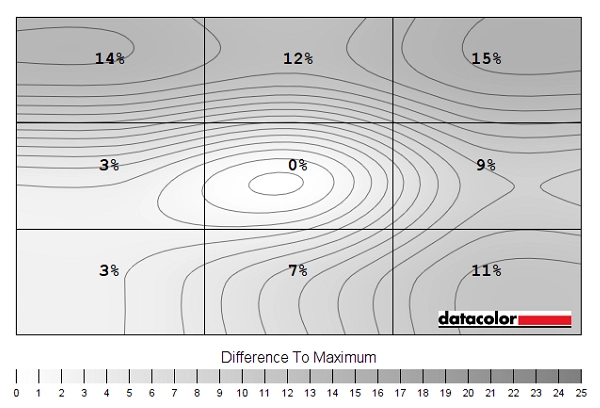
Luminance uniformity map
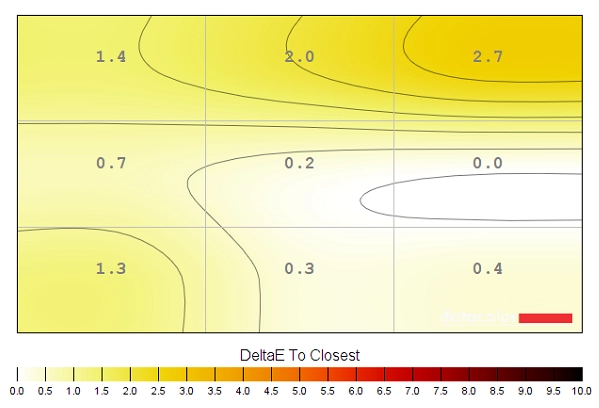
Colour temperature uniformity map
Contrast in games and movies
Lagom contrast tests
Colour reproduction
Colour gamut
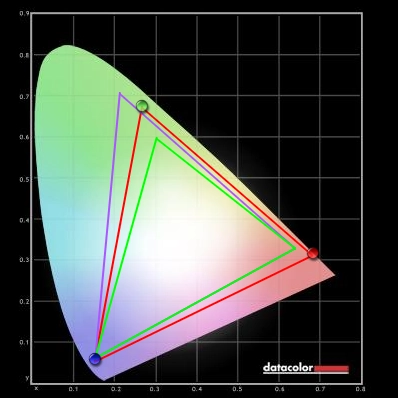
Colour gamut 'Test Settings'
The monitor also provides an sRGB emulation mode (setting ‘Picture Mode’ to ‘sRGB’ in the ‘Picture’ section of the OSD). This significantly cuts back on the colour gamut so that it more closely corresponds to the sRGB reference space. As shown below, the monitor tracks sRGB quite closely with just a sliver of over-extension and a little under-coverage (97% sRGB). As pointed out earlier, the brightness and colour channels are locked when using this setting, which isn’t ideal. The setting can be useful if you require an output closer to sRGB for non colour-managed applications. But if you’re calibrating the monitor with your own colorimeter or similar device then stick to other modes which use the native gamut, for greater flexibility.
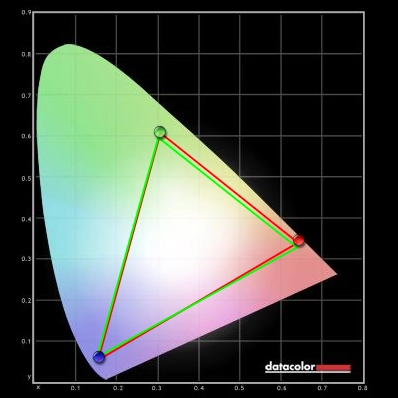
Colour gamut 'sRGB'
AMD GPU users have an interesting alternative available to them which essentially gives them an sRGB emulation mode without these OSD setting restrictions. Rather than setting the monitor to ‘sRGB’, you leave it in a mode that gives you the full native gamut and setting flexibility (brightness, colour channels etc.) and make a small graphics driver tweak. You simply need to open ‘Radeon Settings’, navigate to ‘Display’ – ‘Color’ (little icon towards the top right) and press the ‘Color Temperature’ toggle so it reads ‘Automatic’ instead of ‘6500K’. The gamut below was taken under with our ‘Test Settings’ combined with this small driver tweak.
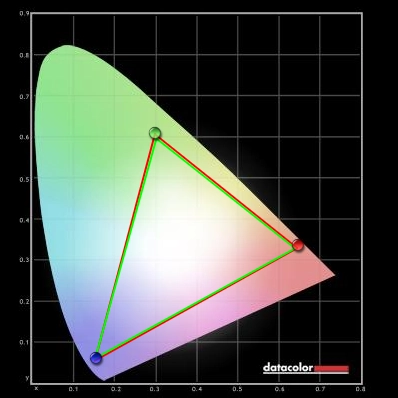
Colour gamut AMD 'Automatic' setting
Colour in games and movies
Viewing angles
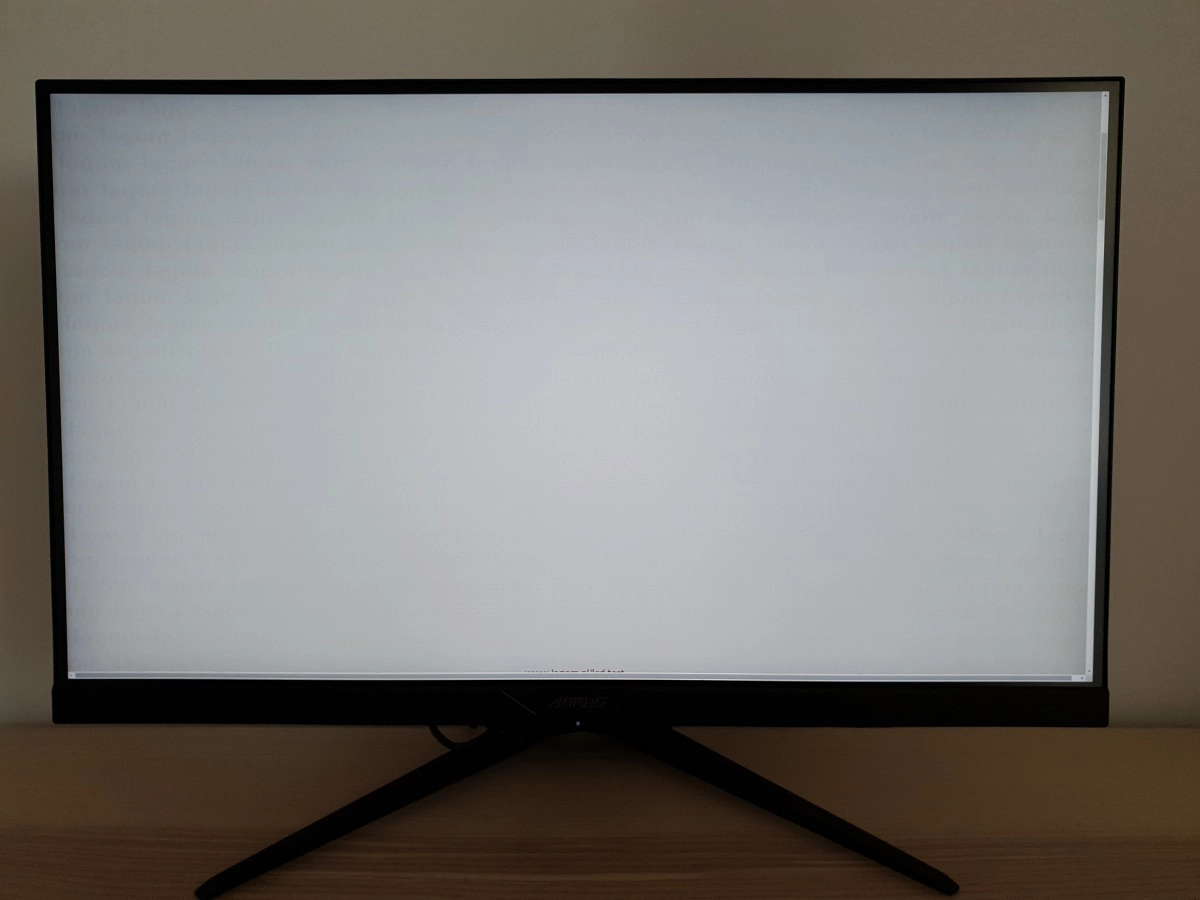
The video below shows the Lagom text test, a mixed desktop background and dark desktop background from a variety of viewing angles. You can see slight shifts in colour and contrast for the mixed desktop background, particularly from more acute viewing angles. These shifts are much less pronounced than on VA or TN models (and indeed some IPS-type models). The dark desktop background highlights ‘IPS glow’, specifically how it blooms out from sharper viewing angles with a strong golden (or slightly cool white, depending on angle) sheen.
Interlace pattern artifacts
Responsiveness
Input lag
Perceived blur (pursuit photography)
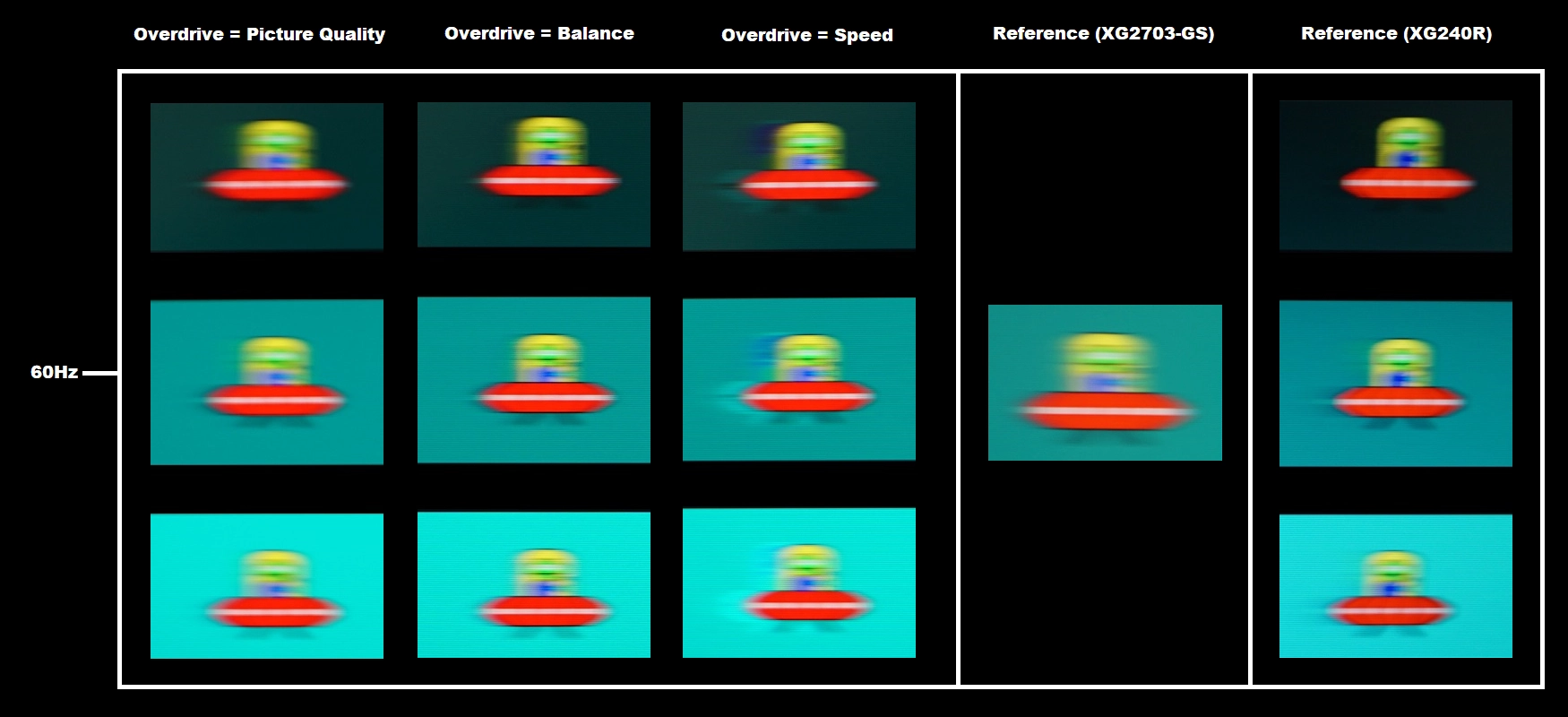
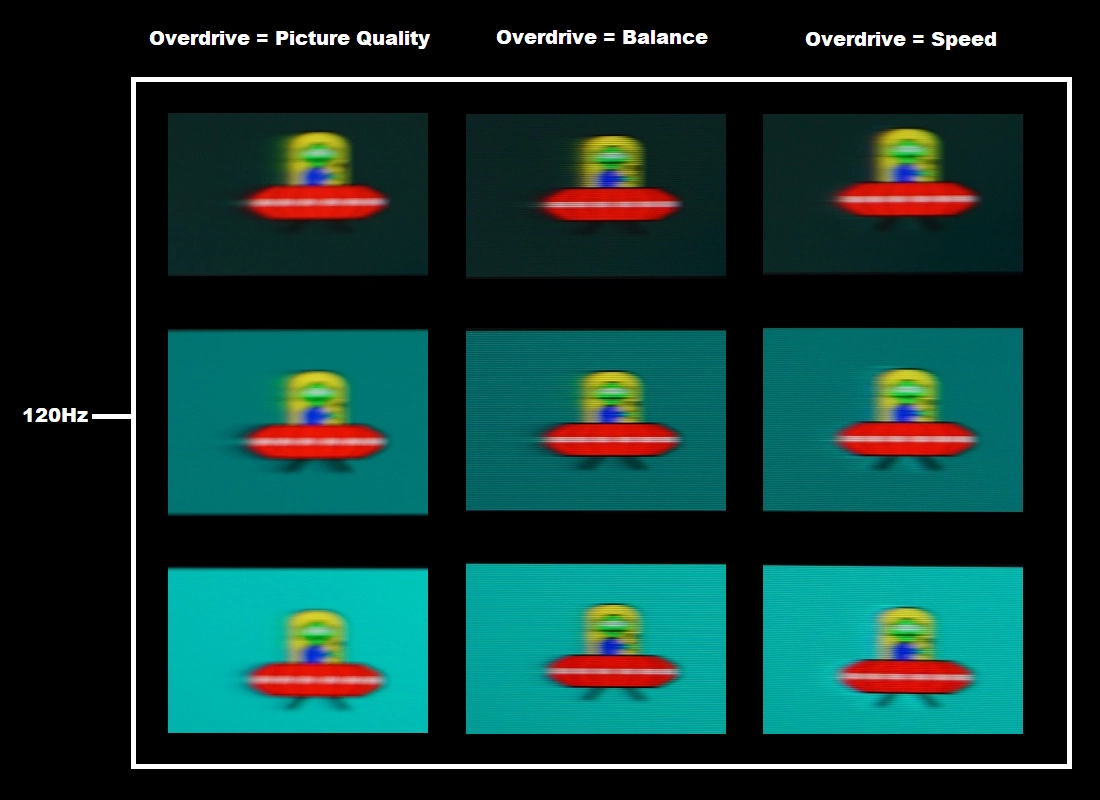
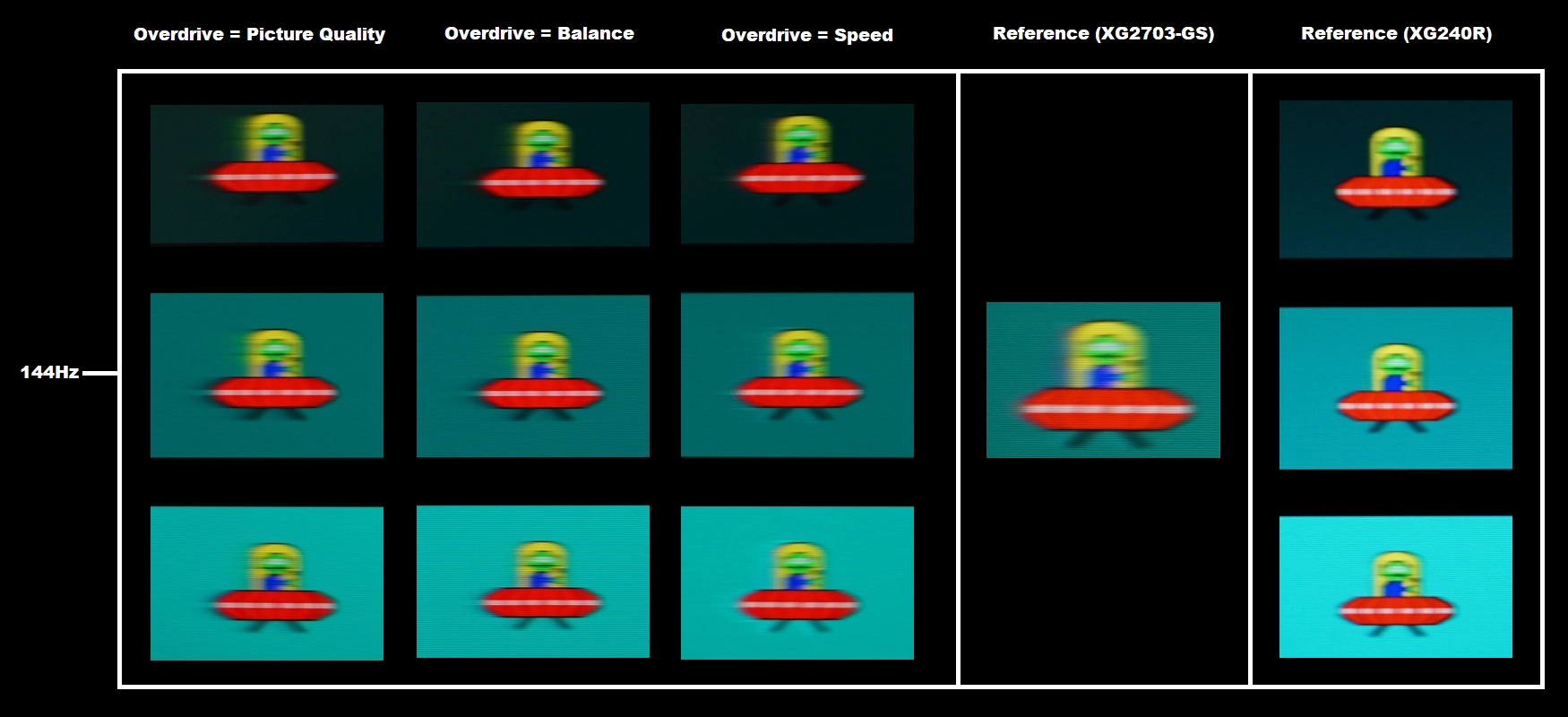


Responsiveness in games and movies
Shadow of the Tomb Raider provided a similar experience in that there was significant benefit from the 144Hz refresh rate, at high frame rates. And the monitor provided snappy pixel responses overall. There were again some instances of ‘powdery’ trailing, but more noticeable were some instances of overshoot. Again, the most noticeable examples of this were bright ‘halo’ trails that occurred in some scenes, such as when moving past medium-grey rocks against brighter areas of sky. The overshoot here was not extreme, but was moderate overall with some isolated examples of strong overshoot – so sensitive users may find it a bit bothersome. We don’t feel using the ‘Balance’ setting is a worthy compromise, because whilst it greatly reduces overshoot it also tones down the pixel response speeds too much for a decent 144Hz high frame rate performance. There are then obvious weaknesses including ‘heavy powdery’ and ‘smeary’ trailing typical of what you might expect to see on some VA models. This ‘Balance’ setting gives a much weaker performance than on the Dell S2719DGF using its low-overshoot ‘Normal’ setting, too.
FreeSync – the technology and activating it
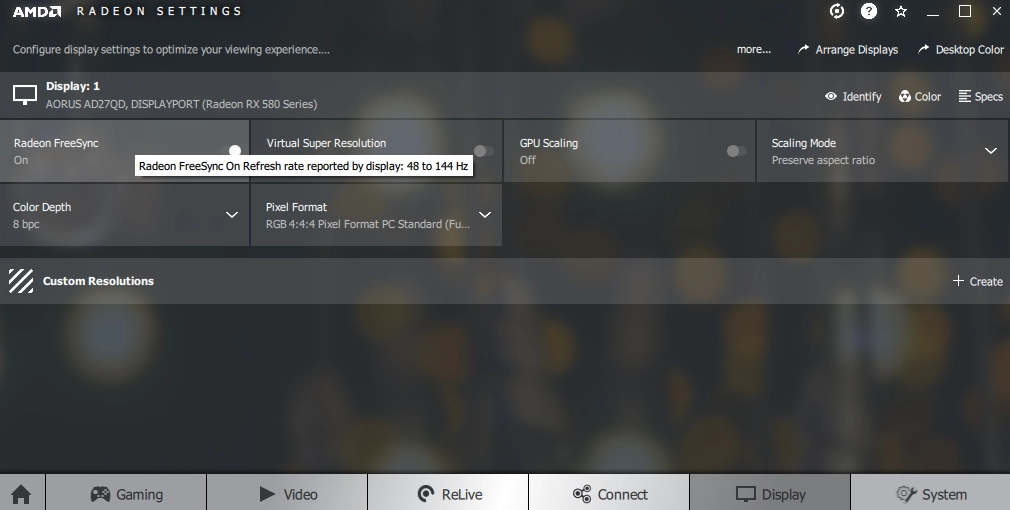
The Gigabyte AORUS supports a variable refresh rate range of 48 – 144Hz. That means that if the game is running between 48fps and 144fps, the monitor will adjust its refresh rate to match. When the frame rate rises above 144fps, the monitor will stay at 144Hz and the GPU will respect your selection of ‘VSync on’ or ‘VSync off’ in the graphics driver. With ‘VSync on’ the frame rate will not be allowed to rise above 144fps, at which point VSync activates and imposes the usual associated latency penalty. With ‘VSync off’ the frame rate is free to climb as high as the GPU will output (potentially >144fps). AMD LFC (Low Framerate Compensation) is also supported by this model, which means that the refresh rate will stick to multiples of the frame rate where it falls below the 48Hz (48fps) floor of operation for FreeSync. If a game ran at 40fps, for example, the refresh rate would be 80Hz to help keep tearing and stuttering at bay. This feature is used regardless of VSync setting, so it’s only above the ceiling of operation where the VSync setting makes a difference.
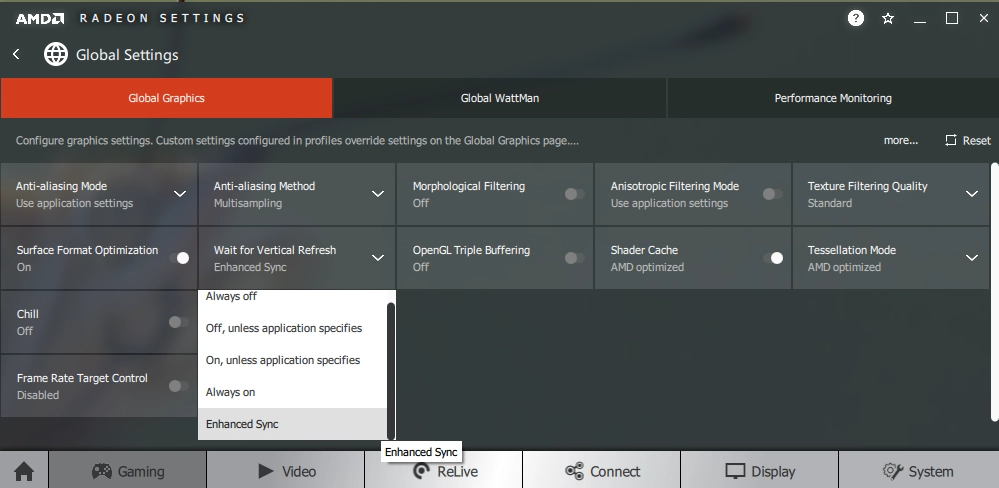
Some users prefer to leave VSync enabled but use a frame rate limiter set a few frames below the maximum supported (e.g. 141fps) instead, avoiding any VSync latency penalty at frame rates near the ceiling of operation or tearing from frame rates rising above the refresh rate. If you enable ‘Refresh Rate’ under ‘AORUS Info’ in the ‘GameAssist’ section of the OSD, this will display the refresh rate of the display and therefore indicate the frame rate if ‘FreeSync’ is active and the frame rate is within the variable refresh rate range of the display. Finally, it’s worth noting that FreeSync only removes stuttering or juddering related to mismatches between frame rate and refresh rate. It can’t compensate for other interruptions to smooth game play, for example network latency or insufficient system memory. Some game engines will also show stuttering (or ‘hitching’) for various other reasons which won’t be eliminated by the technology.
FreeSync – the experience
Nvidia Adaptive-Sync (‘G-SYNC Compatible’)
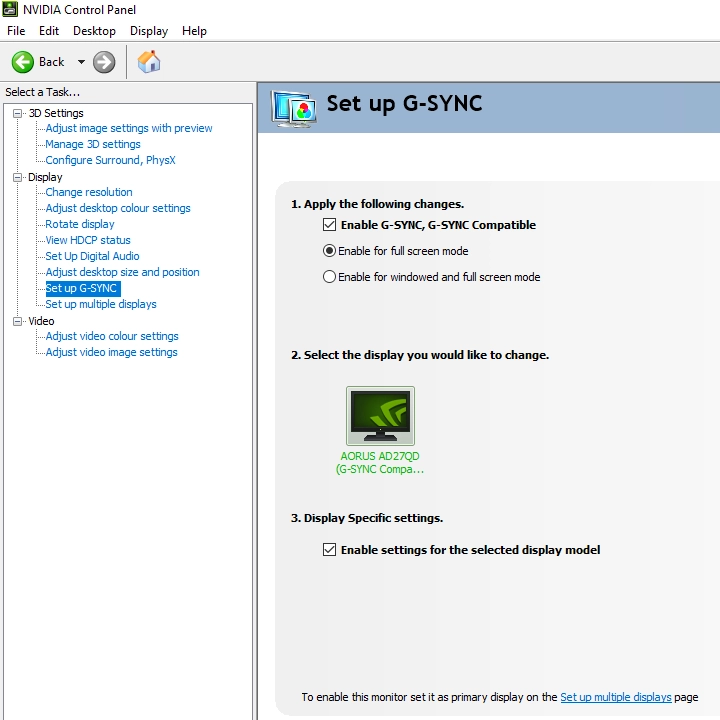
As noted previously and as highlighted in Nvidia Control Panel, this model has been specifically tested and validated as ‘G-SYNC Compatible’ by Nvidia. The experience using Nvidia Adaptive-Sync (G-Sync Compatible Mode) was very similar to the experience using AMD FreeSync on this model. This includes HDR being supported whilst Adaptive-Sync is active. A slight difference is that the floor of operation appeared to be 60Hz (60fps) rather than 48Hz (48fps). However; an LFC-like technology was supported, with the monitor keeping at a multiple of the frame rate with its refresh rate. If anything this was preferable to having the refresh rate dip below 60Hz due to the even more extreme overshoot that would introduce. Although, even at 60Hz or anything near it, we’d still describe the overshoot as pretty extreme using the ‘Speed’ setting of the OSD. As noted in the FreeSync section, pixel overdrive tuning for a broad range of refresh rates is certainly something that Nvidia G-SYNC models handle better than this one.
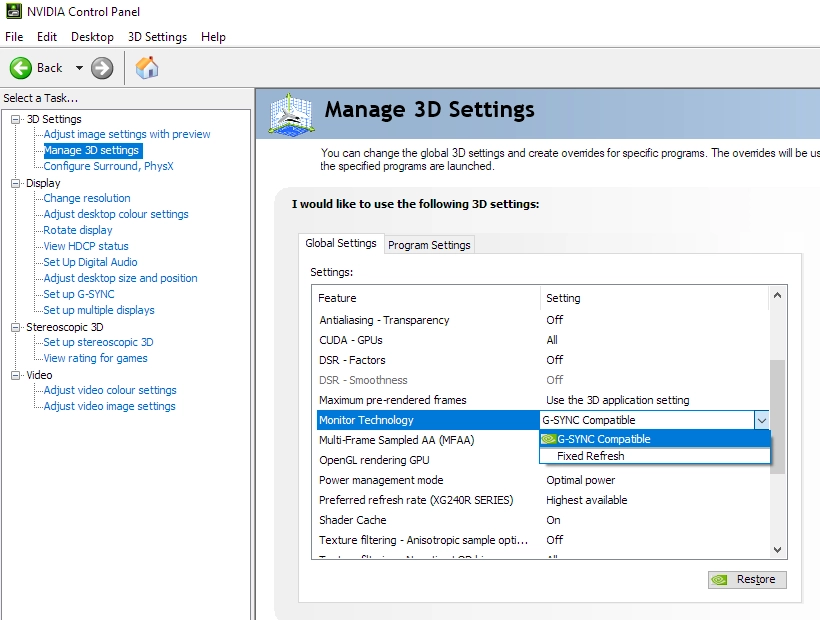
Finally, note again that you can activate ‘Refresh Rate’ under ‘AORUS Info’ in the ‘GameAssist’ section of the OSD, to see if the technology is working. This will rapidly adjust as frame rate fluctuates, whereas if Adaptive-Sync isn’t being used it will stay at the static refresh rate you’ve selected.
Aim Stabilizer
HDR (High Dynamic Range)
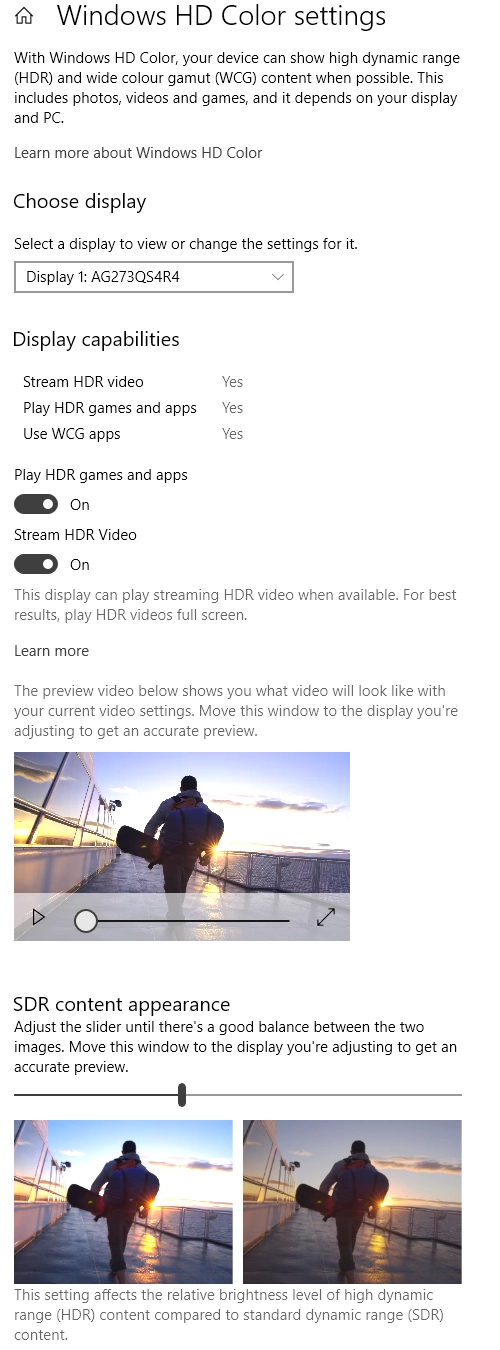

Colour gamut 'Test Settings'
Interpolation and upscaling
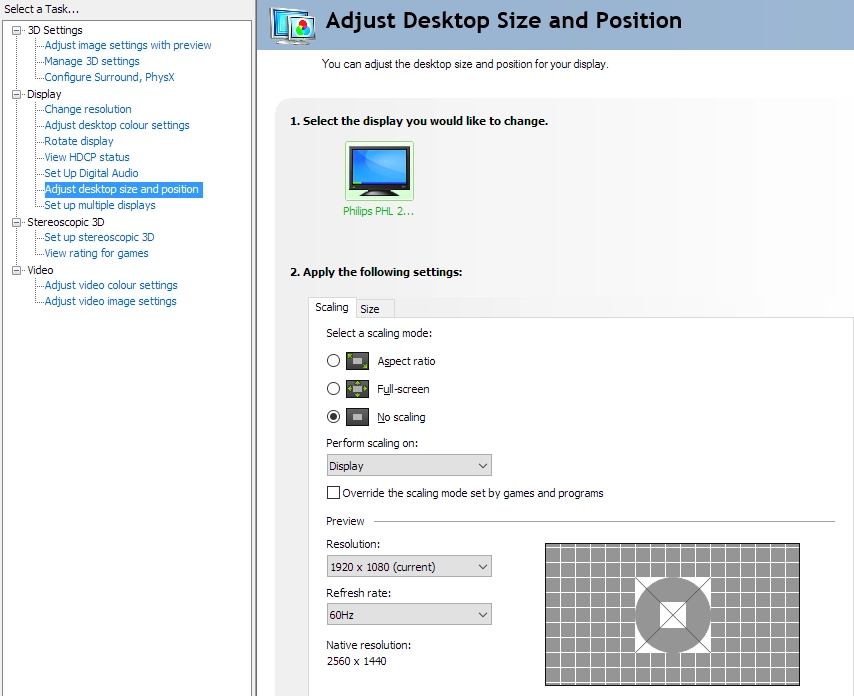
Video review
Timestamps:
Features & Aesthetics
Contrast
Colour reproduction
HDR (High Dynamic Range)
Responsiveness
Conclusion
Positives Negatives A vibrant and varied palette of colours, with strong consistency and a generous colour gamut Weak HDR performance on Nvidia GPU, better but still fairly lacklustre (in terms of contrast) on AMD GPU Decent contrast performance for the panel type and an agreeable screen surface, free from obvious graininess Moderate ‘IPS glow’, typical for the panel type Low input lag and some snappy pixel responses, with Adaptive-Sync working effectively on both AMD and Nvidia GPUs to reduce stuttering and tearing Some weaknesses in pixel responsiveness, most notably overshoot – this becomes extreme at reduced refresh rates (or frame rates, with Adaptive-Sync active). Poor strobe backlight implementation A solid and ergonomically flexible stand, a very feature-rich OSD and a pleasant pixel density and resolution Stand base is fairly deep and the RGB LED lighting feature is useless if viewed from the front of the screen (can’t be used as a bias light)
![]()
